|
THESE PAGES COMMEMORATE THE SERVICEMEN FROM TRING
WHO FELL DURING
THE GREAT WAR
(28th July 1914 to 11th November 1918)
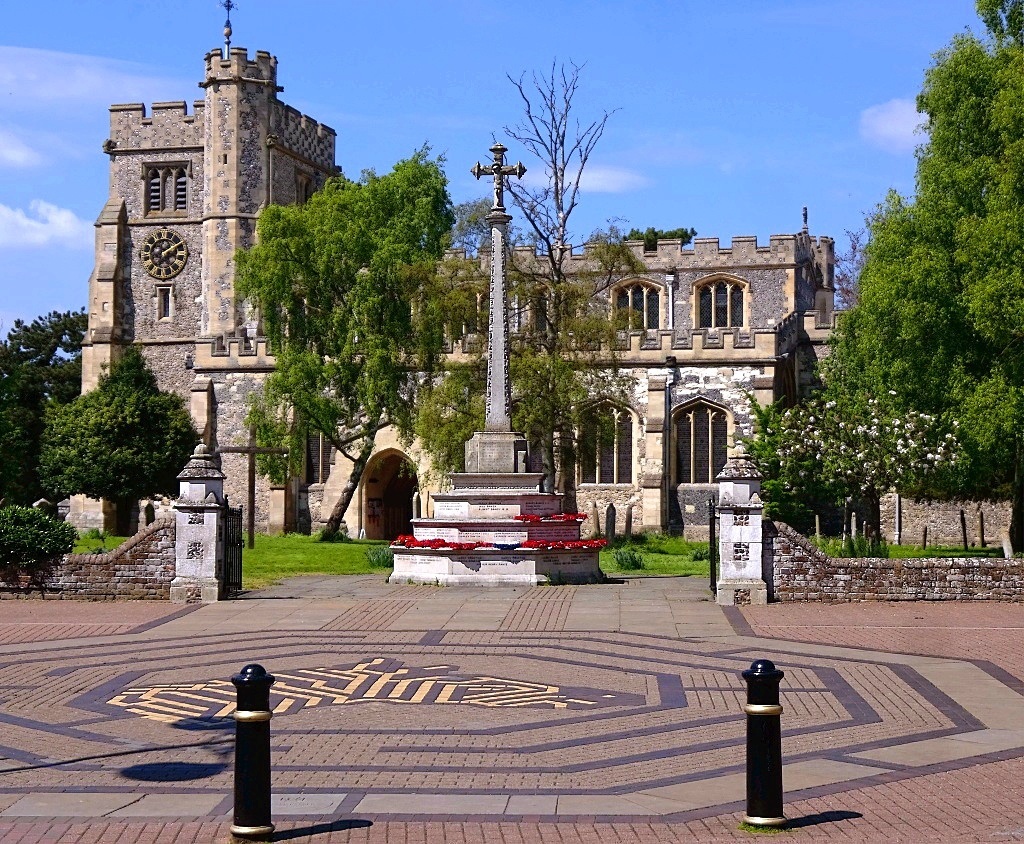
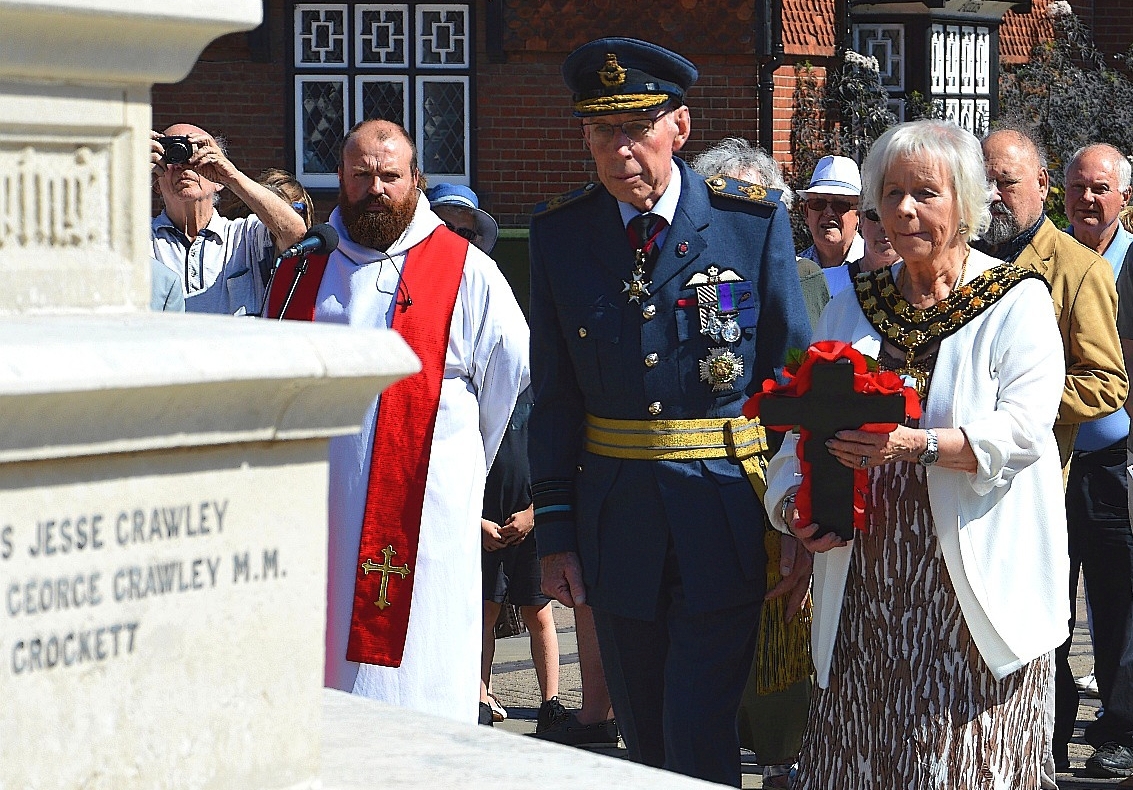
Rededication of the Tring War Memorial,
Saturday 30th June 2018.
Left to right − The Reverend Huw
Bellis, Rector; Air Marshal Sir Michael Simmons, KCB, AFC, RAF; Councillor
Mrs. Penny Hearn, Mayor of Tring.
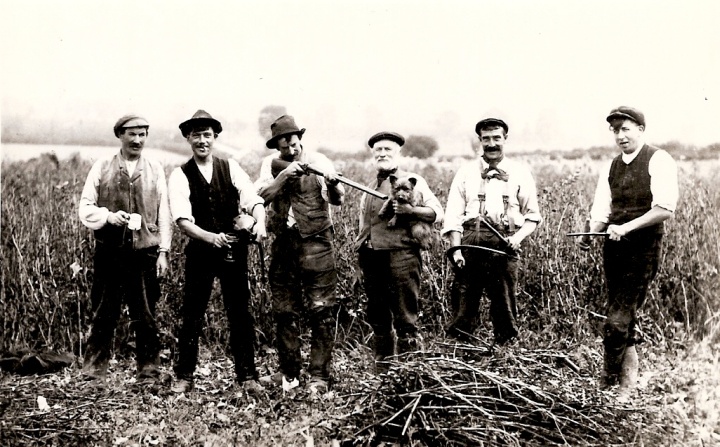
Most of the town’s young men who fought
“for King and Country” had unskilled occupations,
such as the farm labourers pictured above.
|
ACKNOWLEDGEMENTS
My thanks to Tring local historians Jill Fowler and Mike Bass, who
provided me with what photographs survive of the servicemen named on
the Tring War Memorial together with copies of Census, military and
other documents.
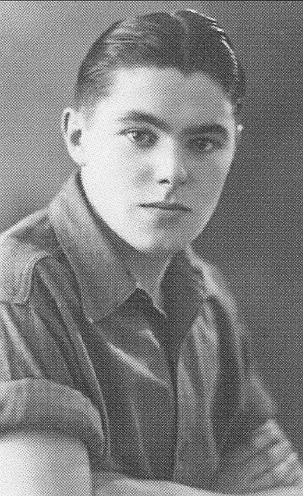
John Bowman (1926-2013)
I acknowledge also the work of the late John Bowman who made copies of the Great War
obituaries that appeared in contemporary
editions of the Parish
Magazine, which I have reproduced, and thank local historian Wendy Austin for the
use of her article on the Tring War Memorial and other
photographs and documents. Tim Amsden, Chairman of the Tring &
District Local History Society, kindly drew my attention to the
Dean of Lincoln’s personal connection with
the Tring War Memorial.
Not being a
military historian I have had to drawn extensively on the records of the
Commonwealth War Graves Commission
and the publications of the military historians who have analysed
the battles of the Great War and the parts played by the battalions
involved − my thanks to them also.
Finally, any reader who can contribute further documented information
relating to the servicemen whose names appear on the Great War section of
the Tring War Memorial can
contact me via the e-mail address at the foot of this page.
Ian Petticrew
May 2017
――――♦――――
|
|
INTRODUCTION
To mark the centenary of the 1917 Flanders Offensive (aka The Battle
of Passchendaele and the Third Battle of Ypres) I have attempted to
discover and document something about the fate of each serviceman
whose name appears in the First World War section of the Tring War
Memorial. It is a task that should have been done years ago,
for at this late date there remains little personal information
on those who fell.
Commonwealth War Graves Commission
records identify their memorials, be they war graves or monuments,
while contemporary editions of the Parish Magazine and the Bucks Herald
sometimes provide
a little insight into a soldier’s private life − and here one wonders what sentiment
caused the Herald’s Editor to print
“Archie Halsey has willingly and cheerfully laid down his life at
the call of duty” (Archie was just 19), but then we
inhabit
a more cynical age.
THE LEAD-UP TO WAR
“. . . . the crash will come twenty years after my departure if
things go on like this.”
Otto von Bismarck
Although the Great War (now generally referred to as the First World
War) involved fighting in different parts of the world, so far as
the Allies were concerned their participation in the conflict was
mainly confined to the Western, Middle Eastern and Italian fronts,
and to the War at Sea. Men from or associated with Tring were
to fight in each of these theatres.
The roots of the Great War are long and complex and their relative
importance remains a matter of debate among historians. In the
decades leading up to the war growing nationalism, with national ambitions being placed ahead of
international co-operation, the contempt of one country for another,
the build-up of military strength, and the formation of power blocks
through military alliances led to a political climate in which
large-scale conflict in Europe became almost inevitable.
Shortly before his death in 1898, the great German statesman Otto
von Bismarck saw that Germany was heading for calamity when he said
“. . . . the crash will come twenty years after my departure if
things go on like this” – the ‘crash’ came somewhat sooner.
In Western Europe, poor relations between Germany and France grew
out of the Franco-Prussian War of 1870-71, a conflict that came
about through French fears of the rising might of her
militaristic neighbour, Prussia. Until then Germany had comprised 39
princely states of which Prussia was dominant. France, led by
Napoleon III − who lacked his uncle’s military genius − attempted to
prevent German unification by attacking Prussia, but in the war that
followed she was quickly defeated by superior forces and
generalship, in the process losing parts of the regions of Alsace
and Lorraine. This caused much French
resentment and a determination by France to regain her lost territories.
The unification of Germany into a politically and administratively
integrated nation state followed the French capitulation in the
Franco-Prussian War (18th January 1871).
Under the first Kaiser (Emperor), Wilhelm I., and his Chancellor,
Otto von Bismarck, German unification led to an upsurge in national energy
and expansion, and by 1914 Germany had become one of the world’s most powerful
industrial nations after the U.S.A.
|
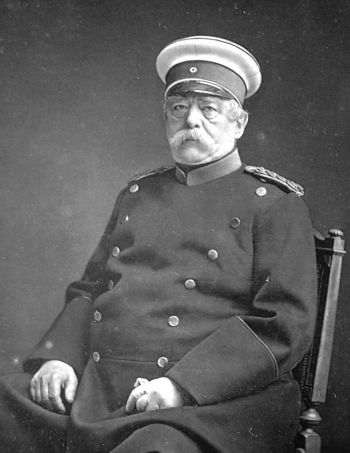 |
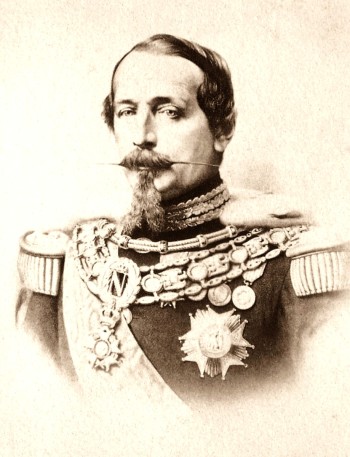 |
|
Otto von Bismarck
Chancellor of Germany 1871-90 |
Louis-Napoléon Bonaparte
Emperor of the French 1852-70 |
To the east of the newly unified Germany were the Poles, whose
country was divided between Germany, Austria-Hungary and Russia.
They too wanted unification as a sovereign state as did the Czechs who had
lost their national independence in 1620 and were under
Austro-Hungarian rule. Although Serbia was independent, many
Serbs also lived under Austro-Hungarian rule and they too wanted self-government. Underlying these nationalist
aspirations was Russia’s belief that she was the
protector of all Slavic peoples regardless of who governed them.
In 1908, Austria-Hungary annexed the former Turkish province of
Bosnia-Herzegovina, a country of nearly 50 percent Serbian
ethnicity; indeed, about half of Austria-Hundary’s subjects were
now Slavs. In response to the annexation, adjacent Serbia
mobilised while calling on Slav protector Russia for assistance.
Germany replied by backing Austria-Hungary. Russia, still lame from its defeat in the Russo–Japanese War of
1905, was forced to back down while the threat of German intervention also
compelled Serbia to acquiesce, but the crisis left both she and Russia
determined that they would not retreat in the future, and such
was to be the case.
Further adjustment of national boundaries in the Balkans followed in
1911-12 with the Italo-Turkish War (1912-13) and the two Balkan Wars
(1912–13), each involving territory that had been governed by the
now decaying Ottoman Empire (i.e. the Turks).
Consequently, by 1914 Europe was a hotbed of nationalist feeling
with tensions running high.
In addition to growing nationalist aspirations in Europe there was a
race among European nations to build empires in Africa, which
sometimes led to serious friction. The ‘Fashoda Incident’ of
1898 left Britain and France on the verge of war over a French
attempt to control the Upper Nile basin, which would have
excluded Britain from the Sudan. The French eventually
acknowledged British control over Egypt, while Britain recognised
France as the dominant power in Morocco. Another crisis that nearly led to war
occurred in 1905-6 when Germany and France clashed over the control of Morocco; a second
scare followed in 1911. Both incidents led to worsening relations
between Germany and both France and Britain (who supported the French).
The growth of military alliances was a further factor that led to a nationalist
squabble ending in war. In 1879,
Germany and Austria-Hungary formed a defensive alliance. This
so-called
Dual Alliance was created by the German Chancellor Bismarck as a
strategy to prevent or limit war by committing the two powers
to support each other if either were to be attacked by Russia, at
that time seen as their main threat. In 1892 France
and Russia formed their own military alliance, the Dual
Entente, which left Germany with unfriendly powers to both east and
west.
By the early 1900s these political alliances had developed.
Italy joined the Dual Alliance, which then became the Triple Alliance, although
as events turned out Italy did not enter the war in 1914. In 1907, Britain joined
Russia and France to form the Triple Entente. However, unlike the
Triple Alliance or the Franco-Russian Alliance, the Triple Entente
was not aimed at mutual defence, leaving Britain free to make
its own foreign policy decisions. Then, in 1914, shortly before the
outbreak of war, Germany entered into a military alliance with the Ottoman
Empire.
THE OUTBREAK OF WAR
“One day the great European War will come out of
some damned foolish thing in the Balkans.”
Otto von Bismarck
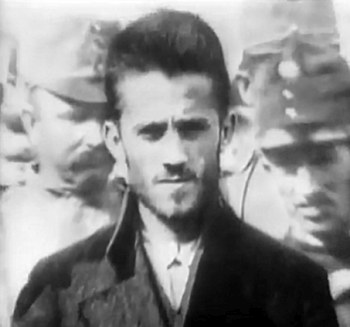
Gavrilo Princip, assassin of
Archduke Franz Ferdinand
and his wife |
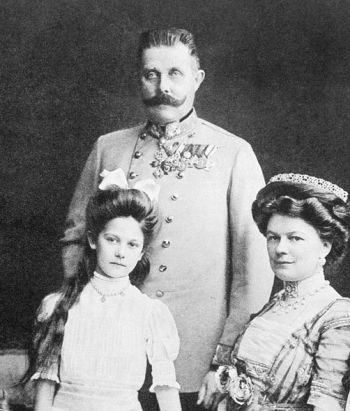 |
|
Archduke Franz Ferdinand with his wife Sophie,
Duchess of Hohenberg, in 1910 |
The Great War was triggered by a
terrorist act that ought not to have resulted in anything more than
a local dispute, but for the reasons described in the previous
section events escalated out of control.
In June 1914, Archduke Franz Ferdinand, heir to the Austro-Hungarian
throne, travelled to Sarajevo in Bosnia-Herzegovina with his wife
Sophie to inspect imperial forces based there. This territory, part of the former Ottoman empire, had been
annexed by Austria-Hungary in 1908 to the indignation of Serbian
nationalists who believed it should have become part of the newly
independent Serbia (due to 50 percent of its population being of
Serbian ethnicity). The royal couple were driven in an open
car with little security when, having taken a wrong
turning, their vehicle happened to pass 19-year-old Serbian nationalist Gavrilo Princip. Princip was part of a gang, the
‘Black Hand’, whose
aim was to unite all Serbs under one rule. A number of its members
had planned to assassinate the Archduke earlier in the day, but their
plan had failed. Seeing this unexpected opportunity, Princip
drew his revolver and fired
into the car at point-blank range wounding Franz Ferdinand and
Sophie, both of whom died shortly after.
The assassination set off a rapid chain of events.
Because the ‘Black Hand’ was a Serbian nationalist group, the
Austro-Hungarians opted to take the opportunity of stamping their
authority on the Serbians, crushing the nationalist movement there
and cementing Austria-Hungary’s influence in the Balkans, but they did
not foresee the disastrous domino effect their actions, backed by
military alliances, would
precipitate:
|
1914 |
|
28th June |
Gavrilo
Princip assassinates Franz Ferdinand and his wife Sophie |
|
23rd July |
Austria-Hungary makes unacceptable demands of Serbia |
|
28th July |
Austria-Hungary declares war on Serbia |
|
31st July |
Russia
mobilises in response to Austro-Hungarian attack on
Serbia |
|
1st August |
Germany
declares war on Russia. France and Belgium
mobilise |
|
2nd August |
The Ottoman
Empire (Turkey) and Germany enter into alliance |
|
3rd August |
Germany
declares war on France |
|
4th August |
Germany
violates Belgian neutrality, causing Britain to declare
war on Germany |
|
6th August |
The
Austro-Hungarian Empire declares war on Russia |
|
12th August |
Britain and
France declare war on Austria-Hungary
Serbia is invaded by Austria-Hungary |
|
23rd August |
Japan
declares war on Germany |
|
2nd November |
Russia
declares war on the Ottoman Empire |
|
5th November |
France and
the British declare war on the Ottoman Empire |
As the war progressed, further acts of aggression drew other
countries into the conflict including the United States (6th April
1917).
THE SCHLIEFFEN PLAN
Britain did not enter the war in response to Germany’s declaration
of war on France, but following Germany’s invasion of Belgium.
Under the 1839 Treaty of London, the U.K. was one of the European powers
that recognised and
guaranteed Belgium’s independence and neutrality. Having
declared war on France, Germany brought into action her established
plan of attack, the ‘Schlieffen Plan’, which involved crossing
Luxembourg and Belgium in contravention of their neutrality.
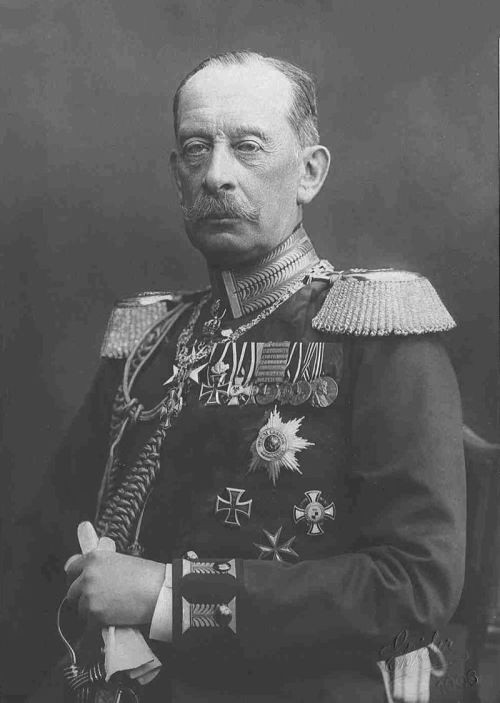 |
|
Field Marshal Count Alfred
von Schlieffen in 1906 |
Between 1897 and 1906 Field Marshall
Alfred von Schlieffen, Chief of the German Imperial General Staff,
drew up a plan of attack designed to enable Germany to beat France
quickly in any future war. The plan assumed that France would declare war on
Germany before Russia, that Russia would take a long time to
mobilise and that Britain would stay out of the
conflict. Under these circumstances 90 per cent of the German
army would be available to swing down through Belgium and northern
France (thereby avoiding strong French fortifications to the south)
to strike a huge hammer-blow at Paris and quickly defeat France.
Following victory over the French − estimated to take 6 weeks − most German
troops would be free to journey east to confront the huge Russian army.
But as the military commanders of the Great War were to discover,
large-scale set piece battle plans tend to start falling apart from the outset, and
that devised by Count Schlieffen was to be no exception.
His plan began to unravel when Russia, rather than
France, declared war on Germany and mobilised her forces to attack
Eastern Prussia more
quickly than Schlieffen had anticipated. This unexpected turn of
events obliged Germany to hold back more
reserves than planned, thereby reducing the size of the
force available for attacking France. German troops met
stronger than expected resistance
from the Belgian army, which slowed their progress, added to which,
following Germany’s violation of Belgian neutrality,
Britain unexpectedly entered the war on the side of France (which
led German Chancellor Hollweg to exclaim that he could not believe
that Britain and Germany were going to war over a mere ‘scrap of
paper’ – i.e. the 75-year old Treaty of London).
Germany next met with two battlefield setbacks. The
British Expeditionary Force (BEF)
and the advancing German First Army ran into each other unexpectedly
near Mons in Belgium, and although eventually driven back by larger
forces, in the ensuing Battle of Mons the BEF inflicted heavy
casualties on its opponent. During a later rearguard action –
The Battle of Le Cateau (26th August 1914) – we sustained heavy
losses in men and equipment, but the action was successful in
allowing the majority of the BEF to escape the advancing German
army.
The BEF continued their withdrawal until the outskirts of
Paris came in sight. Here, they joined the French in their counter-attack.
At the
First Battle of the Marne (5th–12th September 1914) the Germans suffered a
defeat that forced their withdrawal along a 250 mile front; The Schlieffen Plan
was dead.
Following the First Battle of the Aisne (12th-15th
December) there began ‘The Race to the Sea’,
during which both sides began digging in, and the
trench warfare that was to characterise the following four years of fighting
along
what came to be known as the ‘Western Front’
began.
Of the 107 names listed on the Great War section of the Tring War
Memorial, 92 were killed in action on the Western Front or died
after being invalided to the United Kingdom suffering from wounds, gassing, or disease. The remaining
fifteen died in other theatres of war or while on service within the
United Kingdom.
THE BATTLEFIELD
During the Great War the Allies mounted several large-scale offensives designed to break
through the German lines and inflict major strategic defeats, but
what limited success they achieved was at great cost in human life
(the most successful large-scale offensive, and the only one mounted
by the Germans, was their Spring
Offensive of 1918).
Coupled with over-optimistic strategic objectives were
battlefield failures; by the artillery to destroy enemy defences; in
battlefield tactics (e.g. walking towards the enemy lines in
the belief their defences had been destroyed); in coordination
between units; and in communications between units and their
command. Although more successful tactics gradually emerged as
the war progressed (see, for example, ‘Bite
and Hold’ and the tank, designed to overcome the deadlock of
trench warfare), commanders were at first slow to learn from their
mistakes and continued to employ tactics that had already proved
unsuccessful. But the great unpredictable was the weather; the
direction of the wind could assist or hinder a poison gas attack,
while persistent rain could seriously obstruct a campaign as it did
during the 1917 Flanders Offensive.
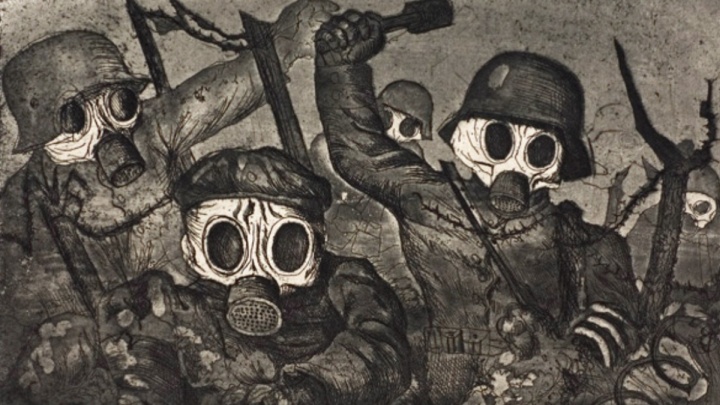
‘Stormtroopers advancing under
a gas attack’ − a drawing by Otto Dix in the Cloth Hall, Ypres.
The Germans’ use of mustard gas at
Passchendaele caused untold suffering to men and horses.
A large-scale offensive that has earned a particularly notorious
reputation was
The Battle of the Somme, which commenced in July 1916. Four and a
half months later the fighting ended, the Allies having gained
little. Mud, blood and futility − more than 3 million
troops (mainly Franco-British and German) took part in the
conflict, one million of whom were wounded or killed making the Somme
one of the bloodiest battles ever fought. To mark the battle’s
centenary, local historian Wendy Austin published a collection of
letters that had been sent to friends and relatives in Tring by
servicemen fighting in various theatres of the First World War. (THEY
CALLED US TO ARMS)
|
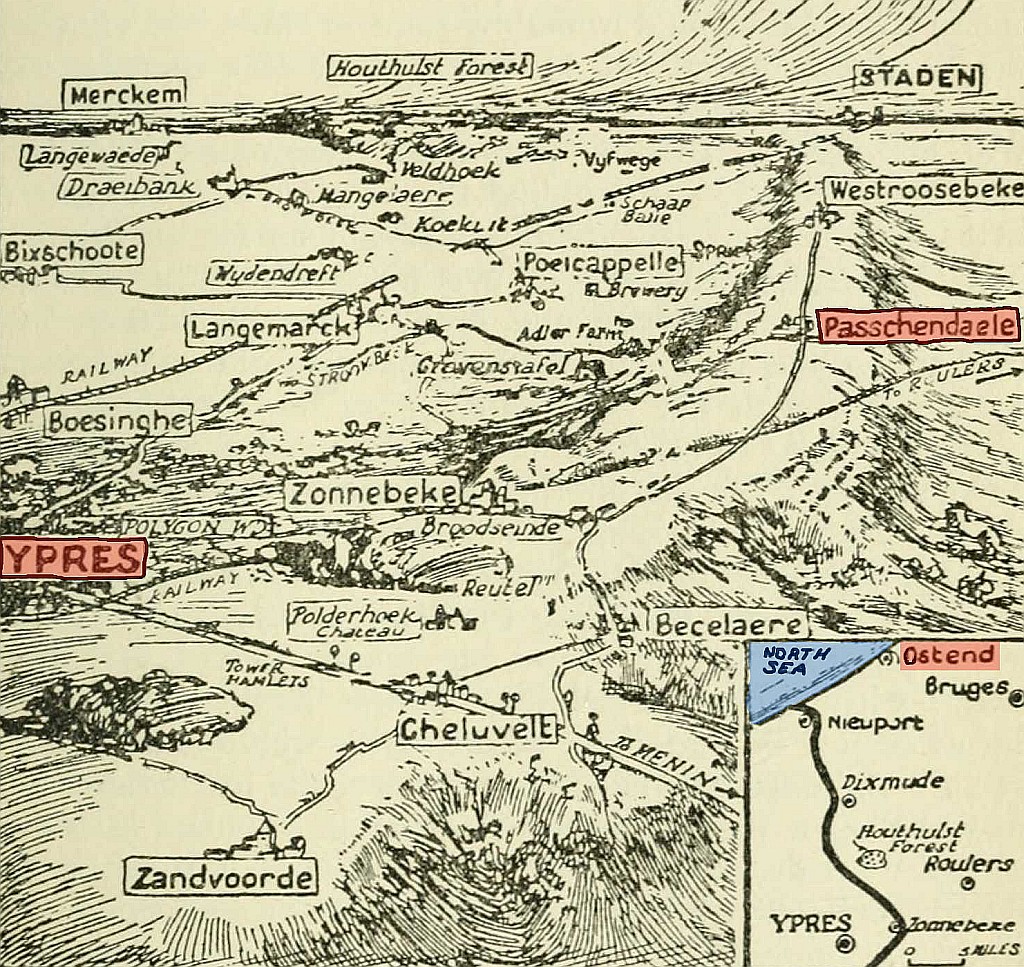
|
Twelve months after the Somme followed a further bloody conflict, the
Flanders Offensive. This series of battles (11th July–10th
November 1917) aimed to occupy the high ground of the Passchendaele Ridge,
thereby securing a good position from which to
thrust forward to the the Belgian coast and to the ports of Ostend and Zeebrugge.
Both ports were used by German shipping, but Zeebrugge
was also home to the German submarine pens that supported the U-boat
campaign then being waged with great success against Allied shipping.
The offensive was also intended to relieve pressure on the French to
the south, whose forces were then experiencing mutinies stemming
from the huge losses they had suffered at the Battles of Verdun, the
Somme and the Aisne (2nd).

|
Soldiers of an Australian
4th Division field artillery brigade on a duckboard
track passing through Chateau Wood, near Hooge in the
Ypres salient, 29th October 1917. The leading
soldier is Gunner James Fulton and the second soldier is
Lieutenant Anthony Devine. The men belong to a
battery of the 10th Field Artillery Brigade.
Australian War Memorial collection number E01220.
|
The initial British-led attack (the Battle of Messines) was
successful, but within hours of the final phase of the offensive
commencing it began to rain. And rain continued with little
remission in the following weeks making the assault on Passchendaele
a name synonymous with seas of mud in which men and animal perished,
as well as with the blood, horror and human sacrifice which by then
had come to characterise trench warfare.
|
“The Somerset and Lincolnshire
formed up under the greatest difficulties, and at 6 a.m.
attacked the enemy. But from the time they left
their assembly positions both battalions came under
murderous machine-gun fire . . . . Owing to the whole
plateau being swept by these machine-guns and also by
the machine-guns from the south, it was decided that the
attack could not get over the ground and, owing to
casualties, the
original line was occupied.”
Passchendaele (Battle of Broodseinde),
4th Oct. 1917
History of the Lincolnshire
Regiment |
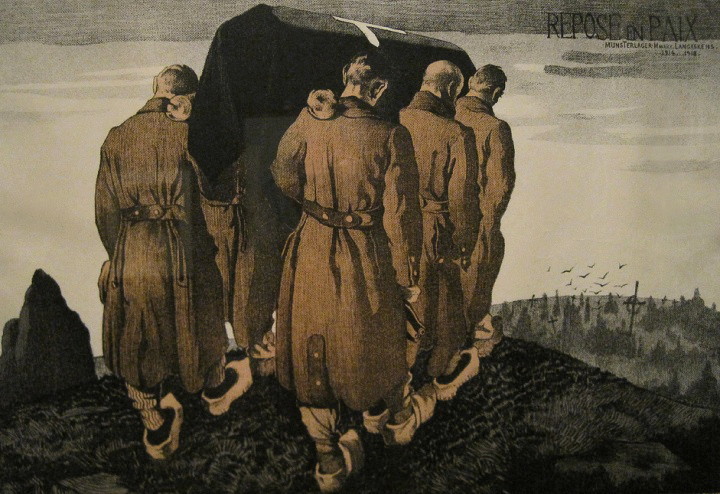
Repose en Paix - a prisoner of war camp funeral cortege, by
Maurice Langaskens,
the Cloth Hall, Ypres.
Against the advice of those on the ground and often in appalling
weather the Allied attacks continued sporadically until November,
when the fighting eventually ended with the capture of the Belgian village of Passchendaele
by Canadian forces.
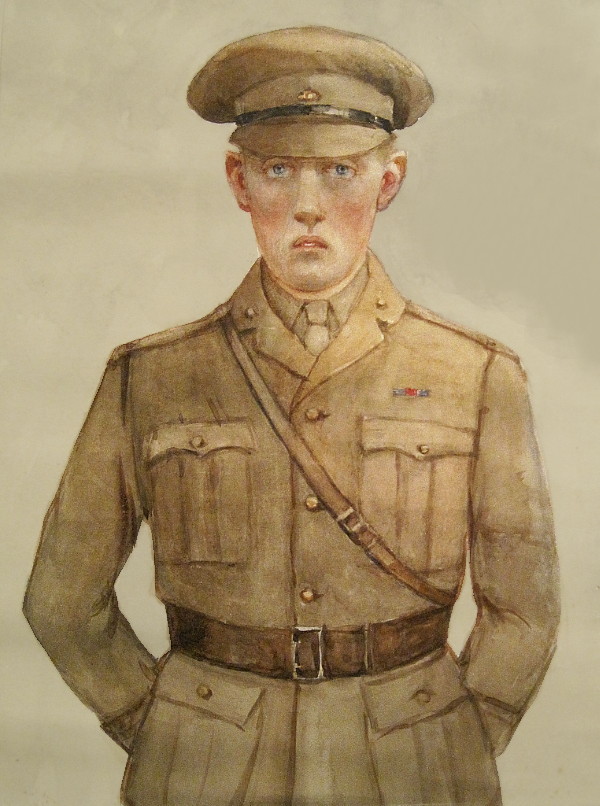
Portrait of a young British army
officer, the Cloth Hall, Ypres. Artist unknown.
Overall, the offensive achieved little, and the impact on the
progress of the war of what has come to be known simply as
‘Passchendaele’ remains controversial, for the scale of its
casualties – estimated at 325,000 Allied troops – fail to justify
its modest achievements (German casualties are estimated at
260,000). Four months later came the German Spring Offensive [Note]
during which the Allies were driven off this shockingly hard-won
ground.
Writing in his War Memoirs, wartime Prime Minister David
Lloyd George expressed the
view that “Passchendaele was indeed one of the greatest disasters
of the war . . . . No soldier of any intelligence now defends this
senseless campaign . . . .” But some military historians argue
that following the Somme, the Flanders Offensive further eroded
Germany’s ability to wage war, for by then American troops were about to enter
the conflict and with increased human resources the Allies could far better
afford the cost in human life than their adversary.
|
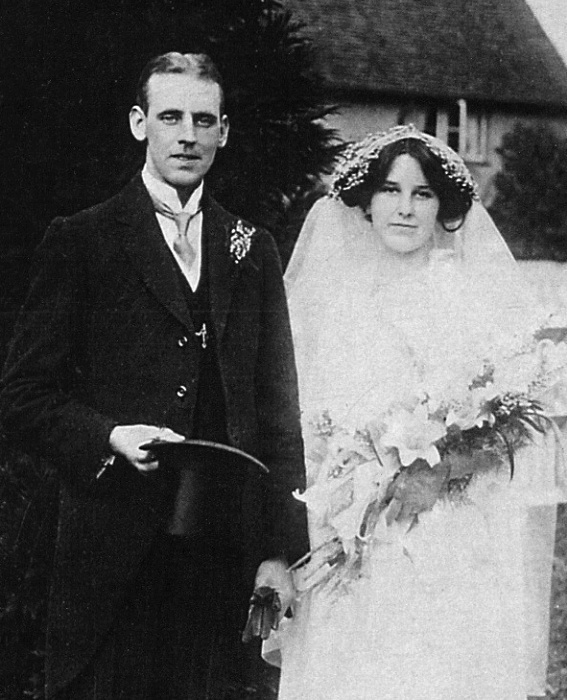 |
|
Reginald Rolfe and Doris
Plater on their wedding day at Aston Clinton, 28th October 1914.
Reg died from injuries on the 26th September 1916 after his aircraft
was shot down. He was 26. |
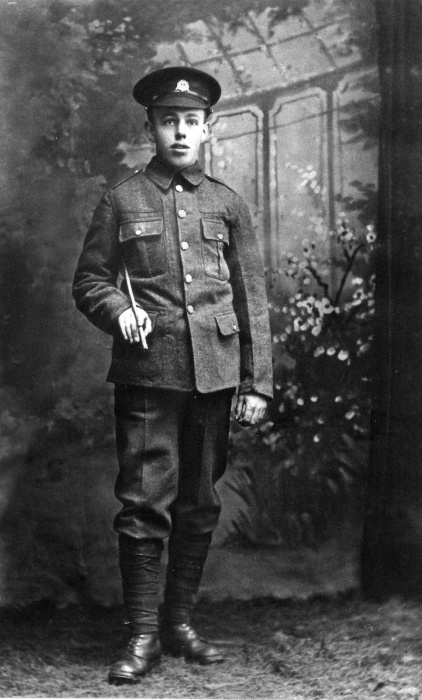 |
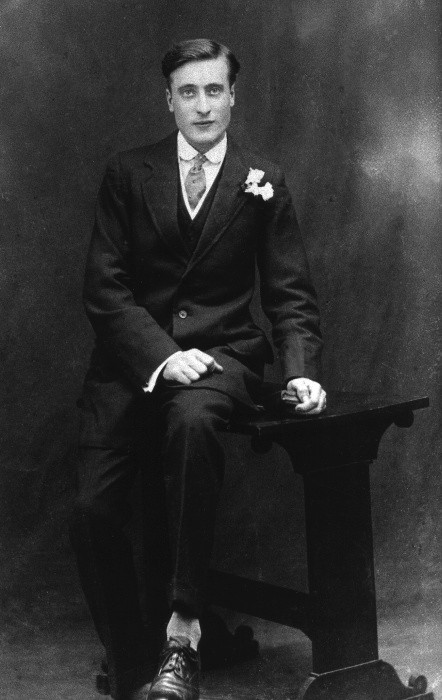 |
|
Charles Harrowell, was killed in action on the
19th April 1915, aged
19.
He has no known grave. |
Herbert Hazzard was killed in action
on the
1st April 1916, aged 21. |
|
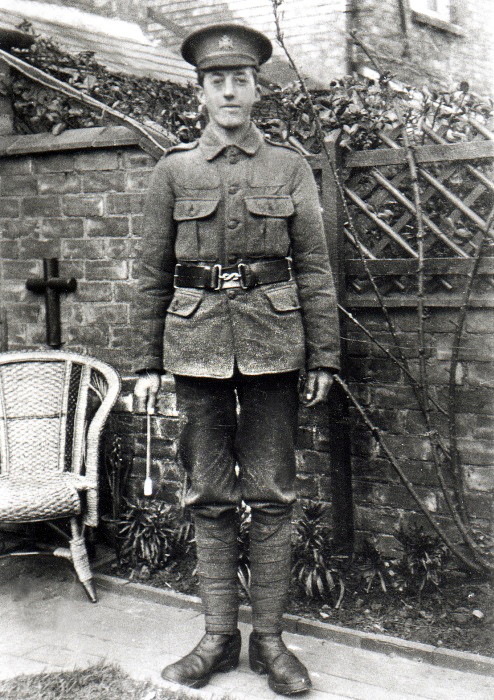 |
|
Harry Prentice was killed in action on the 19th July 1916,
aged 18.
|
From the Battalion War Diary, 19th July 1916: ”with
a cheer, the four waves leapt up and assaulted the
enemy’s trenches. Even before 5.40 p.m. the
enemy’s machine guns had become busy, and at 6 p.m. they
mowed down our advancing waves, so that only a few men
actually reached the German parapet. These did not
return.”
From the Chaplain: “I thought it might be a comfort
to you to know that I buried him with his comrades in a
burial ground, where a cross has been erected over his
grave with name on, etc. His grave will be well
cared for.”
Headstone inscription: GOD BE WITH
YOU TILL WE MEET AGAIN. |
|
|
The few wartime letters that survive sometimes give details of a soldier’s fate, but letters from the regiment to grieving
relatives often appear a mere form of words . . . . “he was a great favourite and was highly respected” . . . .
is the sort of cliché that crops up, but then nothing more might be
expected when the rapid turnover of personnel gave soldiers
little time in which to really know each other. An
obituary in the Bucks Herald read “. . . . there were none
of his friends left to send his parents any particulars of how he
met his death”, but when such particulars were sent home, one
wonders whether they did
anything to help parents or spouse cope with their grief – “He
was hit by a sniper’s bullet . . . . It was hard lines for him . . .
He was buried in a cemetery in as good conditions as can be expected”,
or
this news of the death of Private Edward Barber V.C. “. . . . while doing his duty he was picked off by
a German sniper, the bullet piercing his brain . . . .”
So
often the young man − for most were young − was left where he fell
to have, like Barber V.C., ‘no known grave’.
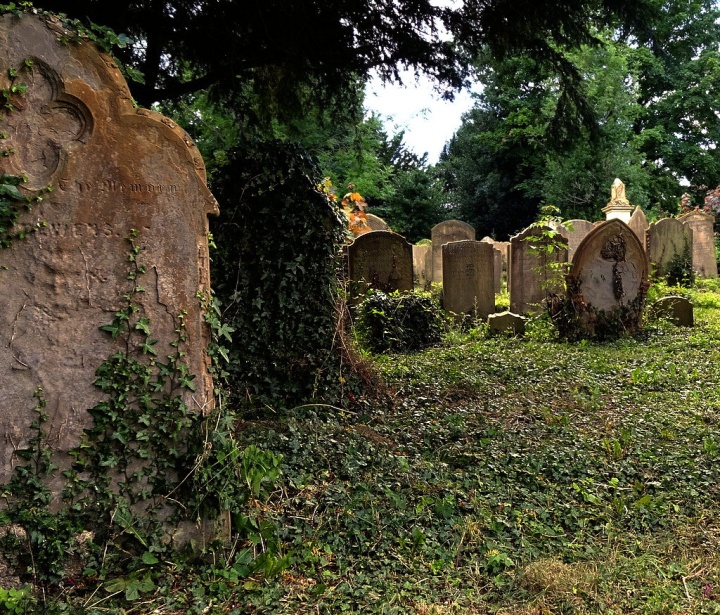
New Mill Baptist Church Cemetery, Tring.
In this beautiful secluded cemetery is
the grave of
Private Charles Miller,
2nd Oxfordshire and Buckinghamshire Light Infantry.
Invalided out of the army after contracting rheumatic
fever in the trenches, 5th October 1915.
Died 17th August 1916, aged 25 years.
Previously unmarked, Charles’s grave was marked with a cross in
November 2019.
――――♦――――
THE TRING WAR MEMORIAL
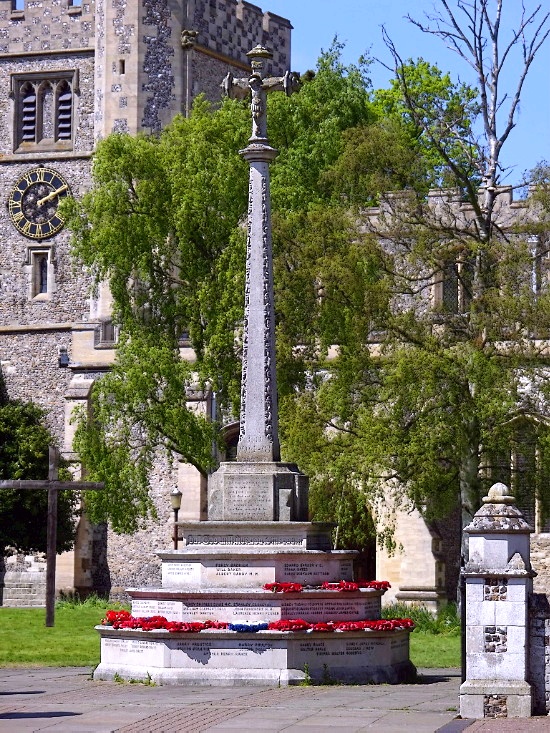
|
TRING WAR MEMORIAL
Grade II-listed
THREE-STEPPED STONE BASE SURMOUNTED BY PLINTH, SHAFT AND
CRUCIFIX. INSCRIPTION ON PLINTH IS CARVED AND
NAMES ARE IN BLACK LEAD LETTERING. GRAPE AND
FOLIATE DESIGN IN RELIEF ON THE SIDE EDGES OF THE
SHAFTS. THREE-STEPPED STONE BASE SURMOUNTED BY
PLINTH, SHAFT AND CRUCIFIX. INSCRIPTION ON PLINTH
IS CARVED AND NAMES ARE IN BLACK LEAD LETTERING.
GRAPE AND FOLIATE DESIGN IN RELIEF ON THE SIDE EDGES OF
THE SHAFTS. |
On
November 27th 1918, just sixteen days after the Armistice at the end
of the Great War, a significant event for the towns folk of Tring
was enacted on Church Square, when the war memorial commemorating
those who had fallen was unveiled in a ceremony led by the
Dean of
Lincoln.
It over a century since the outbreak of that conflict, and from this
distance in time it is difficult to appreciate the different
attitudes and sentiments that then prevailed. An account in the
Parish Magazine of the time relates that when war was declared,
six hundred men from Tring volunteered immediately or shortly
afterwards. Over eighty of these volunteers came from the ranks of
the local branch of The Church Lads’ Brigade. After the Military
Service Act came into force, three hundred more men were
conscripted, and the total then represented one-fifth of the
population of the town. Of the nine hundred men serving, Tring lost
one hundred and seven, a casualty rate more or less typical of
the country as a whole.
The town was more forceful than many others in its urgency to
remember with gratitude the young men who had given their lives in
what was believed and stated to be ‘the war to end all wars’. (Having since lived through the rest of the twentieth century, this
description is now viewed with cynicism and near despair. In 1918 it
would have been beyond imagination that in less than thirty years,
more space on the Memorial would be needed for the names of those
killed in a second world conflict).
A plan for the erection of a war memorial in Tring was first
proposed in March 1917 by the town’s Chairman of the Church Council. He stated that he had recently read an article by
the great surgeon, Stephen Paget, who suggested that the names of the dead in the
Great War be presented in well-shaped legible letters on veined or
lustrous marble, with sufficient spacing for each name to be shown
in full. Mr. Paget further explained his idea by saying: “Over
all these names there might be the figure of Christ on the cross −
not shut in churches, but set in the open air. Such a figure is
singularly close to the war, and the Dead. In all art, there is no
solitary figure so effective.”
Tring took these comments to heart and by August of that year the
Church Council was in a position to consider the submissions of
various architects. The unanimous selection was a drawing by Philip
M. Johnston FSA, FRIBA, who was asked to visit the site and submit a
more detailed plan together with an estimate of cost. The chosen design of an
old English cross carrying the figure of Christ, rose to a height of
twenty-three feet above a square plinth, which rested on top of a
three-tier octagonal base (on which is now inscribed the names of
those who fell in the Great War). Donations were
requested, and the required total of £575. 5s. 10d. was soon raised.
It was hoped that the unveiling could take place on St. Peter’s Day,
but the contractors were so overwhelmed with work on military
gravestones that the event had to be postponed until the autumn.
When building work was complete the memorial was swathed in a Union
flag until the unveiling and dedication ceremony. (As the war was
still not over, the cross was erected without the carving of the
names). Referring again to the Parish Magazine we learn
that after a week of drenching rain and high winds the unveiling day
dawned fine and sunny. A small platform was erected in front
of the new memorial for General Sir William Robertson, who performed
the ceremony, together with the Dean of Lincoln, the Vicar of Tring and the
architect, Philip Johnston. Leaders of other religious faiths
were also represented. The square must have been an impressive
sight, for the guard of honour and band was supplied by one hundred
men of the Inns of Court Officer Training Corps, whose recruits had
trained on nearby Berkhamsted Common. Tring turned out in
force, for during the four years of conflict most people in the town had
lost a relative or friend.

General Sir William
Robertson at the unveiling ceremony, 27th November 1918.
The clergymen (from left to right) are
Dr. Thomas Fry (Dean of Lincoln) and the Revd. Henry Francis (Vicar
of Tring).
Later, when the names were inscribed on the memorial, the list
included seven men who had won decorations − one Victoria
Cross; one Distinguished Conduct Medals; three Military Crosses (one
being with bar); and
three Military Medals. In 1914 many of the soldiers from Tring had
left for France with the Herts Territorial Battalion which took part
in several engagements, with the Guards Brigade in the Second
Division. These men fought at the second Battle of Ypres, where the
battalion lost all its officers, and all but one hundred and thirty
of its men. Later in that same year, the battalion saw action on the
Somme, again losing all its replacement officers as well as five
hundred men. Other Tring men in the Beds & Herts Regiment
also saw action on the Somme, the 7th Battalion advancing at
7.30 am on the first day of the battle (1st July 1916). The Regimental
history relates that the objective of capturing the first-line
system of German trenches was achieved, but the price paid had been
the loss of all its officers.
Tring’s promptness in erecting its war memorial set an example for
many other towns and villages in the country. This was commended in
several newspapers including the Evening News in June 1919, and in
October of the same year the Cardiff Evening Express printed
a picture of the memorial with the headline: “AS IT SHOULD BE”,
the caption beneath stating: “The only War Memorial as yet properly
completed and with the names inscribed. Our picture shows the
beautiful War Memorial at Tring, Hertfordshire.”
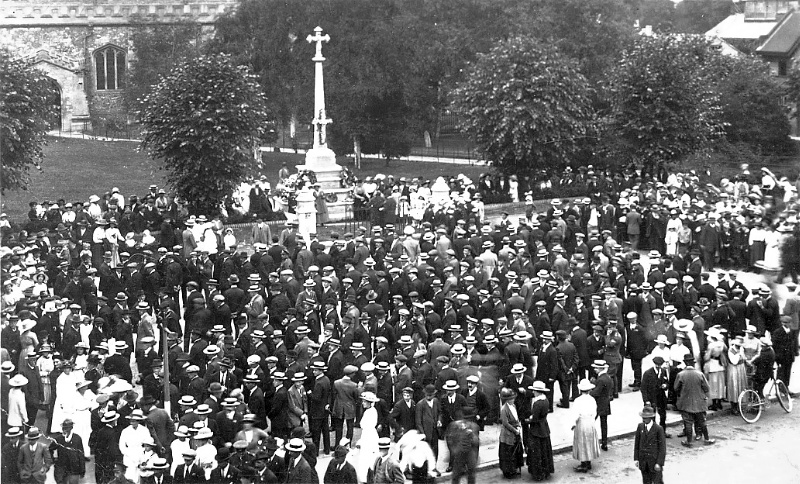
Thanksgiving for
Peace on Church Square, 24th July 1919.
Three months previously a special day had been declared as a
National Thanksgiving for Peace, and at the request of the returning
servicemen, a short informal service was held on Church Square to
honour those killed in the conflict. The relief at the end of all
the slaughter and deprivations, rightly or wrongly, triggered the
Council to suggest that a celebration should follow the service. This took the form of a gathering in Tring Park with sports events,
a fancy dress parade, and tea served to over one thousand five
hundred people. In the evening there was a firework display and a
torchlight procession. However, the arrangements for the special day
had not been entirely trouble-free. Dispute had arisen between the
organisers over the tricky question of whether or not to provide
free beer. This caused committee members to split into two factions,
one staunch chapel-goer stating: “There is great danger in the
suggestion of free beer.” Another opposed this view and said: “After
the experiences of the men, and what they have gone through, it is
humbug to think they should not have a glass of beer.” In spite
of this commonsense approach, the proposal to give beer was defeated
by fifteen votes to twelve. Those unable to get to the park on that
day were not forgotten, for in the following week, an entertainment
with lavish tea was arranged for all those over sixty-five years,
including those described as ‘cripples and the afflicted’, and the
wives of men who fell in the war.
For many years Tring’s war memorial was
half-hidden by the gates in the churchyard wall, which were only
opened on Remembrance Sundays. At that time Church Square was a car
park which grew increasingly busy over the years, and the resulting
bustle caused the memorial to be over-shadowed. In the 1990s the
decision was taken to refurbish the square, which included removing the
gates and opening up the area generally. The monument now presents a
striking aspect, as well as an opportunity for quiet reflection −
surely the purpose of those concerned in its original planning and
design.
Wendy Austin.
――――♦――――
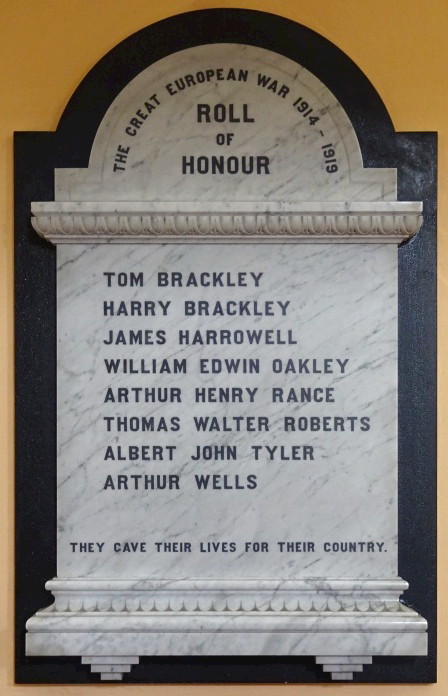
New Mill Baptist Chapel Roll of Honour.
RECRUITING
From the Bucks Herald, 12th September 1914:
Tring is nobly responding to Lord
Kitchener’s call, and many young men—realising that their King and
country need them—are bravely taking their place in the fighting
line. Resigning their employment, giving up their friends,
sacrificing their home ties, their ease, and in many cases their
business prospects, they are flocking to the colours, and, taking
their lives in their hands, are prepared, wherever needed, either at
home or abroad, to serve their King and country. All honour to
them! Their fellow townsmen are proud of them, and regard them
with admiration; and some—whose age prevents them joining the throng
at the recruiting office—with not a little envy.
We published last week the names of the Tring men, as far as we were
able to ascertain them, who have joined the colours. This week
we are able to add other names to the Tring “Roll of Honour”:
—
Batson, Ralph, R.F.A.
Brackley, Tom, Lord Kitchener’s Army
Butler, Eric
Birch, William, Lord Kitchener’s Army
Betts, Alfred, Grenadier Guards
Brookman, John, Herts Territorials
Cox, F, Oxford Light Infantry
Cartwright, Joseph, Durham Light Infantry
Collier, Stanley, A.S.C., Royal Navy
Copcutt, John, Oxford and Bucks Infantry
Dossett, J. T., Dispatch Rider Lord Kitchener’s Army
Dunton, Stanley, 9th Middlesex
Eggleton, John, Oxford Light Infantry
Fenemore, John, Lord Kitchener’s Army
Fenn, William, Canadian Contingent, Durham Light
Infantry
Flower, Captain Stanley, Egyptian Army
Gates, Walter, Lord Kitchener’s Army
Grace, Oliver Gilbert, Dragoon Guards
Grisewood, Leonard, Lord Kitchener’s Army
Harding, W. I., Lord Kitchener’s Army
Holland, Arthur, Oxford Light Infantry
Henley, Frank, Oxford Light Infantry
Harrop, Joseph William, National Reserve |
From the Bucks Herald, 3rd October 1914:
We learn from the Tring Church magazine
that the following from the Church Lads’ Brigade are now on active
service: Ralph Batson, William Charles Birch, Frank Bates, Cyril
Butcher, William Cooper, Joseph Cartwright, Arthur Davey, Stanley
Dunton, John Leonard Harding, Samuel Kesley, Frank Metcalf, Arthur
Probets, Frank Sheeman, William Spinks, Sidney Tite, Charles Wade,
Thomas Welling, Stanley Wilkins, Oliver Wilkins, Arthur Wilkins,
Eric Woodman.
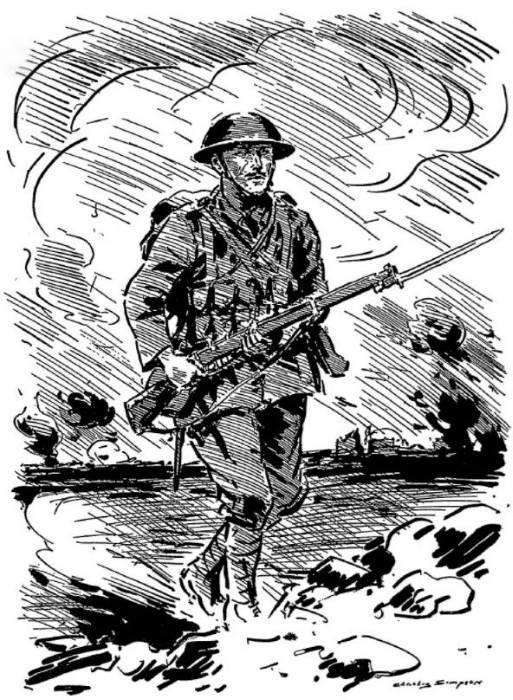
From the Bucks Herald, 29th May 1915:
FORESTERS ON ACTIVE
SERVICE.− No less than 84 members of
Court Albion No4423 Ancient Order of Foresters, Tring Branch, have
answered their country's call. Their names are:−
Albert T D Batchelor, Martin Busby, Arthur Bradding, Albert Baker,
Frank Bates, Frederick W Ball, Raymond D Baker, Sidney J Baldwin,
Horace Baldwin, Gilbert Bridges, Frederick Birch, Ernest Cheshire,
Albert Casemore, William J Croft, Frederick W Cutler, Harry Chappin,
James Dewey, Arthur H Dumpleton, Arthur Davey, Stanley Dunton, Edgar
Bell, Frederick Dedman, John Fenemore, Albert T Grace, Oliver G
Grace, Walter T Gates, Harold Gurney, Leonard Gristwood, Frank
Henley, Ernest Hearn, Frederick B Jellis, Robert Kempster, Sidney
Keel, Sidney Lovell, Frederick Lovell, William J Parslow, Frederick
Parslow, Ernest Payne, Alfred Pheasant, Herbert Hazzard, Arthur
Horn, Reginald Pheasant, Walter J Rance, Arthur Rance, William J
Stratfull, Ernest Seabrook, Fred Smith, John Smith, Frank Saunders,
Frederick W Talbott, John Wells, Arthur Wilkins, Joseph Wilkins,
William Crawley, Thomas Badrick, Arthur Dwight, Horace Dwight,
Ernest Capel, Lewis Marks, Albert Mills, Thomas Biddle, Jesse
Gascoine, George Mills, John Nutkins, William Willing, Ernest Rolfe,
Frederick J Burch, Tom Brackley, Joseph M Burch, Frederick A
Crockett, William G Eggleton, Joe Howes, Thomas Jakeman, Robert W
Millins.
|
――――♦――――
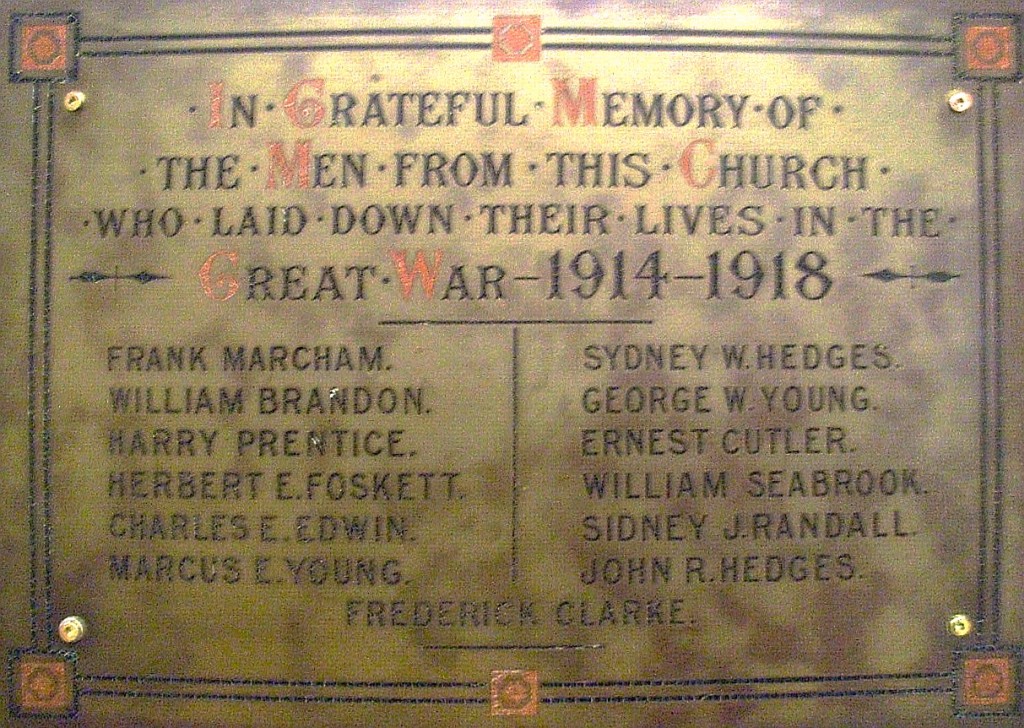
Akeman Street Baptist Chapel Roll of
Honour
|
TRING’S WAR LOSSES
Recruitment figures are estimated.
600 men volunteered immediately or shortly
after the commencement of hostilities − a further 300 were
later conscripted.
107 names are listed on the Tring War Memorial (8 officers, 99 other ranks), of which .
. . .
decorated - 7 (incl. 1 V.C. and 1 twice decorated);
2 Royal Marines: 2 Royal Navy: 3 Royal Flying Corps/RAF;
7 Canadians, 3 Australians;
97 killed in action or died later of wounds/gassing: 1 accidental death: 8
died of disease.
6 million men were mobilised in the UK. Just over 700,000 were
killed, giving a rate of attrition of around 11.7%. The rate
for Tring was 11.9%, or 10.8% if the 10 men who emigrated from Tring to
Canada/Australia before the war are excluded. In the years
following the end of hostilities there were others who died from injuries
or disease that they sustained while on active service, but whose names are
not inscribed on the Tring War
Memorial. [Biog. Note 5]
Some 12% of the British army’s ordinary soldiers were killed during
the war, compared with 17% of its officers.
HORSES
One of the first direct impacts on Tring came very shortly after the
declaration of War (4th August 1914). On 7th August, the day
following the annual Agricultural Show held in Tring Park, horses of
every size and breed were requisitioned, numbered and catalogued
ready for war. What became of them is not known, but it is
most unlikely than any were ever returned to their owners. The
following extract is from the Wikipedia entry, ‘Horses in World War I’:
“Battle
losses of horses were approximately 25 percent of all war-related
equine deaths between 1914 and 1916. Disease and exhaustion
accounted for the remainder and the Germans specifically targeted
horses with gunfire. The highest death rates were in East
Africa, where in 1916 alone deaths of the original mounts and
remounts accounted for 290% of the initial stock numbers, mainly due
to infection from the tsetse fly. On average, Britain lost about 15
percent (of the initial military stock) of its animals each year of
the war (killed, missing, died or abandoned), with losses at 17
percent in the French theatre. This compared to 80 percent in
the Crimean War, 120 percent in the Boer War and 10 percent in
peacetime. During some periods of the war, 1,000 horses per
day were arriving in Europe as remounts for British troops, to
replace horses lost. Some horses, having collapsed from
exhaustion, drowned in ankle-deep mud, too tired to lift their heads
high enough to breathe. Equine casualties were especially high
during battles of attrition, such as the 1916 Battle of Verdun
between French and German forces. In one day in March, 7,000
horses were killed by long-range shelling on both sides, including
97 killed by a single shot from a French naval gun. By 1917,
Britain had over a million horses and mules in service, but harsh
conditions, especially during winter, resulted in heavy losses,
particularly amongst the Clydesdale horses, the main breed used to
haul the guns. Over the course of the war, Britain lost over
484,000 horses, one horse for every two men. A small number of
these, 210, were killed by poison gas.” |
NAMES INSCRIBED ON THE MEMORIAL
IN SURNAME ORDER

14th Northumberland Fusiliers practicing
trench attacking, Halton Camp, 1915.
|
|
DIED |
FAMILY NAME |
RANK AND UNIT |
|
03/04/1917 |
Anderson, John Henry |
Private, 44th Canadian
Infantry |
|
02/12/1917 |
Asquith, Gordon William |
2nd Lieut, 3rd King's
Own Yorkshire Light Infantry |
|
23/10/1918 |
Ayres, James Edward |
Driver, Royal Army
Service Corps |
|
30/05/1918 |
Badrick, Percy |
Rifleman, 2nd Rifle
Brigade |
|
21/10/1915 |
Baker, Will |
Private, Royal Marine
Light Infantry |
|
23/08/1918 |
Bandy, Albert M.M. |
L/Corporal, 18th Bn.
King's Royal Rifle Corps |
|
12/03/1915 |
Barber, Edward V.C. |
Private, 1st Battalion,
Grenadier Guards |
|
20/09/1916 |
Bates, Frank Manfield |
Private, 6th Somerset
Light Infantry |
|
15/05/1917 |
Battson, Ralph Bertram |
Driver, 31st Royal Field
Artillery |
|
28/04/1915 |
Birch, William Charles |
Private, 1st Border
Regiment |
|
17/10/1915 |
Brackley, Thomas |
Private, 1st Battalion
Grenadier Guards |
|
24/03/1918 |
Brackley, Henry |
Gunner, 76th Siege
Battery, Royal Garrison Artillery |
|
04/04/1916 |
Brandon, William |
Private, 27th Bn. Canadian Infantry |
|
12/10/1918 |
Brooks,
George |
Private, 10th
Lancashire Fusiliers |
|
02/07/1916 |
Brown, Andrew Cranstoun |
2nd Lieut, 8th South
Staffordshire Regiment |
|
27/09/1918 |
Burch, Frank M.M. |
Private, 1st
Bedfordshire Regiment |
|
19/11/1916 |
Cartwright, Thomas |
Private, 78th Canadian
Infantry |
|
10/03/1918 |
Cato, Reginald Robert |
Gunner, 31st Royal
Garrison Artillery |
|
07/11/1918 |
Clarke, Frederick Edward |
Private, East Surrey
Regiment |
|
23/11/1918 |
Clements, James |
Gunner, 264th Royal
Field Artillery |
|
05/06/1916 |
Collier, Stanley |
Able Seaman, RN |
|
25/12/1916 |
Collins, Jesse |
Private, 99th Training
Reserve |
|
02/06/1915 |
Crawley,
Charles Jesse |
Private, 2nd Middlesex
Regiment |
|
20/09/1917 |
Crawley, Ultimius George |
Private, 6th Ox and
Bucks Light Infantry |
|
30/07/1916 |
Crockett, George |
Private, 2nd
Bedfordshire Regiment |
|
28/11/1917 |
Cross, Arthur Albert |
Private, Royal Bucks
Hussars |
|
07/09/1915 |
Cross, Herbert William |
Private, 1st Bedfordshire Regimen |
|
22/08/1918 |
Cutler, Ernest |
Private, 7th Norfolk
Regiment |
|
11/07/1916 |
Davey, William |
Private, 2nd
Bedfordshire Regiment |
|
16/03/1917 |
Davey, Henry Arthur |
Private, 6th
Bedfordshire Regiment |
|
13/02/1918 |
Dawe, Sidney Charles M.C. |
Captain, 5th
Lincolnshire Regiment |
|
23/09/1917 |
Dell, William Clement |
Rifleman, 12th King's
Royal Rifle Corps |
|
30/09/1915 |
Dunton, Stanley |
Private, 3rd Battalion
Middlesex Regiment |
|
08/10/1917 |
Eggleton, Stanley Rumball |
Staff Sergeant,
Australian Army Medical Corps |
|
15/07/1916 |
Fenemore, John M.M. |
Sergeant, 64th Machine
Gun Corps |
|
12/10/1918 |
Fenner, Laurence Henry |
Private, 5th Canadian
Infantry |
|
28/04/1917 |
Foskett, Herbert Edward |
Second Lieutenant, 5th
Bedfordshire Regiment |
|
06/08/1917 |
Foster, Stanley Francis |
Private, 6th
Bedfordshire Regiment |
|
28/08/1918 |
Fountain, Sidney Thomas |
Private, 1st
Cambridgeshire Regiment |
|
17/07/1917 |
French, Frederick Arthur |
Private, 6th East
Yorkshire Regiment |
|
12/07/1916 |
Gates, Walter Thomas |
Private, 7th East Kent
Regiment |
|
26/07/1918 |
Gates, Frank John |
Rifleman, 8th Post
Office Rifles |
|
02/11/1918 |
Gates, Herbert James |
L/Corporal, 2nd Ox and
Bucks Light Infantry |
|
13/11/1916 |
Gregory, Frederick John |
Private, 4th
Bedfordshire Regiment |
|
03/05/1917 |
Gristwood, Leonard
William |
L/Corporal, 55th Machine
Gun Corps |
|
28/02/1918 |
Gunn, George |
Private, 11th Royal
Sussex Regiment |
|
21/09/1916 |
Halsey, Archibald |
Private, 1st
Hertfordshire Regiment |
|
26/08/1916 |
Hance, George James |
Private, 2nd Ox and
Bucks Light Infantry |
|
08/10/1915 |
Hardy, Leslie George |
Corporal, 1st Coldstream
Guards |
|
19/04/1915 |
Harrowell, Charles |
Private, 1st
Bedfordshire Regiment |
|
22/10/1917 |
Harrowell, James |
Lance Corporal, 9th
King's Royal Rifle Corps |
|
28/10/1916 |
Hartert, Joachim Charles |
Lieutenant, 8th East
Yorkshire Regiment |
|
05/11/1918 |
Haystaff, Sydney |
Private, 87th Canadian
Infantry |
|
04/05/1917 |
Hayward, Walter |
Private, 6th Australian
Machine Gun Corps |
|
01/04/1916 |
Hazzard, Herbert |
Private, 1st Oxf and
Bucks Light Infantry |
|
16/04/1918 |
Hedges, Sydney Walter |
L/Corporal, 6th
Northamptonshire Regiment |
|
16/11/1918 |
Hedges, John Russell |
Private, 1st
Bedfordshire Regiment |
|
17/11/1916 |
Horn, Joseph |
Private, 2nd Middlesex
Regiment |
|
04/10/1917 |
Howlett, Charles
Frederick |
Private, 8th
Lincolnshire Regiment |
|
17/02/1917 |
Janes, Henry |
Corporal, Royal Marine
Light Infantry |
|
02/10/1917 |
Kempster, Frederick |
Rifleman, 7th Royal
Irish Rifles |
|
13/02/1919 |
King, Ernest |
Private, 4th North
Staffordshire Regiment |
|
25/02/1916 |
Lovegrove, Bert |
Private, 9th East Surrey
Regiment |
|
02/08/1916 |
Lovell, Frederick |
Private, 13th Essex
Regiment |
|
16/11/1918 |
Lovell, Arthur |
Private, 54th Machine
Gun Corps |
|
29/03/1915 |
Marcham, Frank Edgar |
Private, 1st
Hertfordshire Regiment |
|
17/08/1916 |
Miller, Charles |
Private, Oxford and
Bucks Light Infantry |
|
02/06/1917 |
Miller, Stanley |
Corporal, 1st Royal
Bucks Hussars |
|
03/03/1919 |
Miller, William John |
Private, Royal Army
Ordnance Corps |
|
28/04/1917 |
Mills, George |
Private, 112th Machine
Gun Corps |
|
04/12/1918 |
Norwood, William Edward |
Driver, 163rd Machine
Gun Corps |
|
01/08/1916 |
Oakley, William Edwin |
Private, Royal Sussex
Regiment |
|
25/10/1917 |
Oakley, George |
Private, 12th
Northumberland Fusiliers |
|
26/07/1917 |
Philbey, Henry Richard |
L/Corporal, 2nd Beds
Regiment |
|
24/08/1918 |
Pope, Harold Edward M.C.
bar |
Captain, Royal Garrison
Artillery |
|
20/09/1914 |
Poulton, Harry |
Private, 2nd Battalion,
Highland Light Infantry |
|
31/10/1914 |
Poulton, Joseph |
Private, 1st Battalion
Bedfordshire Regiment |
|
14/11/1917 |
Poulton Joseph |
Private, 2nd Northamptonshire Regiment |
|
19/07/1916 |
Pratt, Sidney Richard |
Private, 53rd Australian
Infantry |
|
05/07/1918 |
Pratt, Stanley James |
Sergeant, 48th Sqdn.,
RAF |
|
19/07/1916 |
Prentice, Harry |
Private, 2nd Ox and
Bucks Light Infantry |
|
06/01/1916 |
Rance, Harry |
Bugler, 58th Canadian
Infantry |
|
09/06/1918 |
Rance, Arthur Henry |
Corporal, 62nd Machine
Gun Corps |
|
29/10/1918 |
Rance, Walter |
L/Corporal , 2nd Queen's
Royal West Surrey Regiment |
|
12/11/1918 |
Randall, Sidney James |
Private, Canadian
Expeditionary Force |
|
28/06/1917 |
Rew, Douglas Jolland |
2nd Lieut, 5th Essex
Regiment |
|
23/07/1916 |
Roberts, Thomas Walter |
Private, 7th East Surrey
Regiment |
|
11/06/1918 |
Robinson, Frank |
Private, 17th Tank Corps |
|
26/09/1916 |
Rolfe, Horace Hedley
Reginald |
Air Mechanic 2nd Class,
1st Wing HQ RFC |
|
25/09/1918 |
Seabrook, William
Charles |
Sergeant, 1st Aeroplane
Supply Depot Repair Park, RAF |
|
26/09/1916 |
Spinks, William George
D.C.M. |
Sergeant, 1st
Hertfordshire Regiment |
|
11/01/1918 |
Spinks, Charles Edward |
L/Corporal, 7th
Bedfordshire Regiment |
|
02/11/1918 |
Stevens, Charles Sidney |
Private, 15th Suffolk
Regiment |
|
17/10/1915 |
Stratford, Arthur |
Private, 5th Ox and
Bucks Light Infantry |
|
08/08/1917 |
Turvey, Frederick |
Private, 9th Royal
Dublin Fusiliers |
|
25/03/1918 |
Tyler, Albert John |
Private, 10th Duke of
Cornwall's Light Infantry |
|
07/09/1918 |
Vaisey, Roland Maddison |
Captain, 36th Royal
Field Artillery |
|
22/09/1914 |
Wells, Arthur |
Stoker, Royal Navy |
|
19/02/1919 |
Wells, Arthur Frank |
Private, 74th Royal Army
Ordnance Corps |
|
12/06/1918 |
West, Joseph |
Private, 7th Royal West
Kent Regiment |
|
03/09/1916 |
Wilkins, Arthur |
Rifleman, 10th Rifle
Brigade |
|
04/03/1917 |
Wilkins, Frank George |
Private, 1st
Worcestershire Regiment |
|
16/08/1917 |
Wilkins, Oliver |
Bugler, 1st Ox and Bucks
Light Infantry |
|
03/11/1916 |
Woods, Sidney |
Private, 8th
Bedfordshire Regiment |
|
03/06/1917 |
Wright, Ernest George |
Private, 1st Essex
Regiment |
|
27/05/1918 |
Young, George Walter |
Captain, 8th East
Yorkshire Regiment |
|
24/03/1918 |
Young, Marcus Ernest |
2nd Lieut, Royal Field
Artillery |
|
――――♦――――
NAMES INSCRIBED ON THE MEMORIAL
IN CHRONOLOGICAL (D.O.D.) ORDER
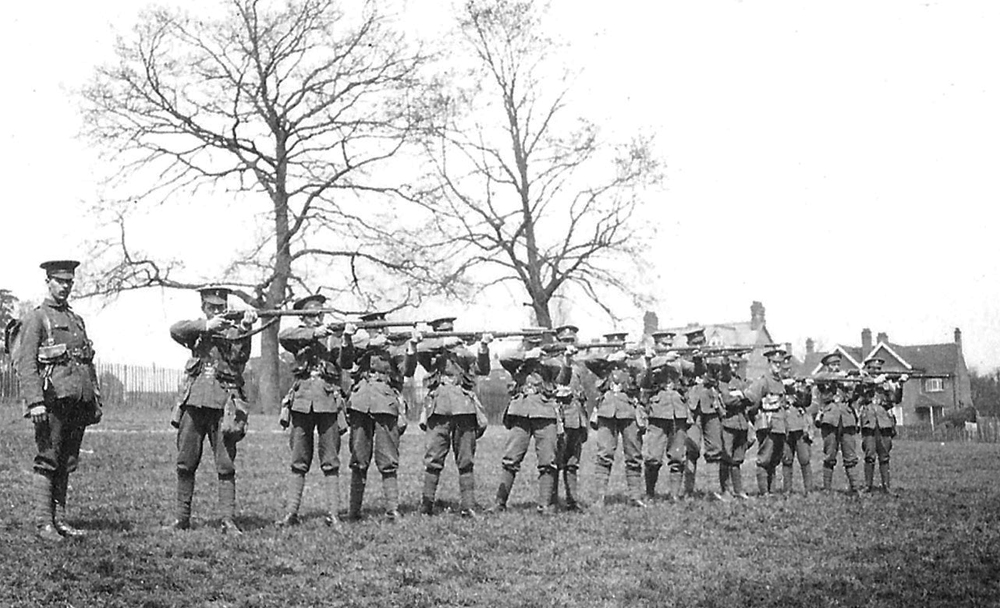
Musketry, 14th Northumberland Fusiliers,
Halton, May 1915.
|
DIED |
FAMILY NAME |
RANK AND UNIT |
|
20/09/1914 |
Poulton, Harry |
Private, 2nd Battalion,
Highland Light Infantry |
|
22/09/1914 |
Wells, Arthur |
Stoker 1st class, Royal Navy |
|
31/10/1914 |
Poulton, Joseph |
Private, 1st Battalion
Bedfordshire Regiment |
|
12/03/1915 |
Barber, Edward V.C. |
Private, 1st Battalion,
Grenadier Guards |
|
29/03/1915 |
Marcham, Frank Edgar |
Private, 1st Hertfordshire
Regiment |
|
19/04/1915 |
Harrowell, Charles |
Private, 1st Bedfordshire
Regiment |
|
28/04/1915 |
Birch, William Charles |
Private, 1st Border Regiment |
|
02/06/1915 |
Crawley, Charles Jesse |
Private, 2nd Middlesex
Regiment |
|
07/09/1915 |
Cross,
Herbert William |
Private, 1st
Bedfordshire Regimen |
|
04/04/1916 |
Brandon,
William |
Private, 27th Bn.
Canadian Infantry |
|
30/09/1915 |
Dunton, Stanley |
Private, 3rd Battalion
Middlesex Regiment |
|
08/10/1915 |
Hardy, Leslie George |
Corporal, 1st Coldstream
Guards |
|
17/10/1915 |
Brackley, Thomas |
Private, 1st Battalion
Grenadier Guards |
|
17/10/1915 |
Stratford, Arthur |
Private, 5th Ox and Bucks
Light Infantry |
|
21/10/1915 |
Baker, Will |
Private, Royal Marine Light
Infantry |
|
06/01/1916 |
Rance, Harry |
Bugler, 58th Canadian Infantry |
|
25/02/1916 |
Lovegrove, Bert |
Private, 9th East Surrey
Regiment |
|
01/04/1916 |
Hazzard, Herbert |
Private, 1st Ox and Bucks
Light Infantry |
|
05/06/1916 |
Collier, Stanley |
Able Seaman, RN |
|
02/07/1916 |
Brown, Andrew Cranstoun |
2nd Lieut, 8th South
Staffordshire Regiment |
|
11/07/1916 |
Davey, William |
Private, 2nd Bedfordshire
Regiment |
|
12/07/1916 |
Gates, Walter Thomas |
Private, 7th East Kent
Regiment |
|
15/07/1916 |
Fenemore, John M.M. |
Sergeant, 64th Machine Gun
Corps |
|
19/07/1916 |
Pratt, Sidney Richard |
Private, 53rd Australian
Infantry |
|
19/07/1916 |
Prentice, Harry |
Private, 2nd Ox and Bucks
Light Infantry |
|
23/07/1916 |
Roberts,
Thomas Walter |
Private, 7th East Surrey
Regiment |
|
30/07/1916 |
Crockett, George |
Private, 2nd Bedfordshire
Regiment |
|
01/08/1916 |
Oakley, William Edwin |
Private, Royal Sussex Regiment |
|
02/08/1916 |
Lovell, Frederick |
Private, 13th Essex Regiment |
|
17/08/1916 |
Miller, Charles |
Private, Oxford and Bucks
Light Infantry |
|
26/08/1916 |
Hance, George James |
Private, 2nd Ox and Bucks
Light Infantry |
|
03/09/1916 |
Wilkins, Arthur |
Rifleman, 10th Rifle Brigade |
|
20/09/1916 |
Bates, Frank Manfield |
Private, 6th Somerset Light
Infantry |
|
21/09/1916 |
Halsey, Archibald |
Private, 1st Hertfordshire
Regiment |
|
26/09/1916 |
Rolfe, Horace Hedley Reginald |
Air Mechanic 2nd Class, 1st
Wing HQ RFC |
|
26/09/1916 |
Spinks, William George D.C.M. |
Sergeant, 1st Hertfordshire
Regiment |
|
28/10/1916 |
Hartert, Joachim Charles |
Lieutenant, 8th East Yorkshire
Regiment |
|
03/11/1916 |
Woods, Sidney |
Private, 8th Bedfordshire
Regiment |
|
13/11/1916 |
Gregory, Frederick John |
Private, 4th Bedfordshire
Regiment |
|
17/11/1916 |
Horn, Joseph |
Private, 2nd Middlesex
Regiment |
|
19/11/1916 |
Cartwright, Thomas |
Private, 78th Canadian
Infantry |
|
25/12/1916 |
Collins, Jesse |
Private, 99th Training Reserve |
|
17/02/1917 |
Janes, Henry |
Corporal, Royal Marine Light
Infantry |
|
04/03/1917 |
Wilkins, Frank George |
Private, 1st Worcestershire
Regiment |
|
16/03/1917 |
Davey, Henry Arthur |
Private, 6th Bedfordshire
Regiment |
|
03/04/1917 |
Anderson, John Henry |
Private, 44th Canadian
Infantry |
|
28/04/1917 |
Foskett, Herbert Edward |
Second Lieutenant, 5th
Bedfordshire Regiment |
|
28/04/1917 |
Mills, George |
Private, 112th Machine Gun
Corps |
|
03/05/1917 |
Gristwood, Leonard William |
L/Corporal, 55th Machine Gun
Corps |
|
04/05/1917 |
Hayward, Walter |
Private, 6th Australian
Machine Gun Corps |
|
15/05/1917 |
Battson, Ralph Bertram |
Driver, 31st Royal Field
Artillery |
|
02/06/1917 |
Miller, Stanley |
Corporal, 1st Royal Bucks
Hussars |
|
03/06/1917 |
Wright, Ernest George |
Private, 1st Essex Regiment |
|
28/06/1917 |
Rew, Douglas
Jolland |
2nd Lieut, 5th Essex Regiment |
|
17/07/1917 |
French, Frederick Arthur |
Private, 6th East Yorkshire
Regiment |
|
26/07/1917 |
Philbey, Henry Richard |
L/Corporal, 2nd Beds Regiment |
|
06/08/1917 |
Foster, Stanley Francis |
Private, 6th Bedfordshire
Regiment |
|
08/08/1917 |
Turvey, Frederick |
Private, 9th Royal Dublin
Fusiliers |
|
16/08/1917 |
Wilkins, Oliver |
Bugler, 1st Ox and Bucks Light
Infantry |
|
20/09/1917 |
Crawley, Ultimius George |
Private, 6th Ox and Bucks
Light Infantry |
|
23/09/1917 |
Dell, William Clement |
Rifleman, 12th King's Royal
Rifle Corps |
|
02/10/1917 |
Kempster, Frederick |
Rifleman, 7th Royal Irish
Rifles |
|
04/10/1917 |
Howlett, Charles Frederick |
Private, 8th Lincolnshire
Regiment |
|
08/10/1917 |
Eggleton, Stanley Rumball |
Staff Sergeant, Australian
Army Medical Corps |
|
22/10/1917 |
Harrowell, James |
Lance Corporal, 9th King's
Royal Rifle Corps |
|
25/10/1917 |
Oakley, George |
Private, 12th Northumberland
Fusiliers |
|
14/11/1917 |
Poulton,
Jospeh |
Private, 2nd Northamptonshire
Regiment |
|
28/11/1917 |
Cross, Arthur Albert |
Private, Royal Bucks Hussars |
|
02/12/1917 |
Asquith, Gordon William |
2nd Lieut, 3rd King's Own
Yorkshire Light Infantry |
|
11/01/1918 |
Spinks, Charles Edward |
L/Corporal, 7th Bedfordshire
Regiment |
|
13/02/1918 |
Dawe, Sidney Charles M.C. |
Captain, 5th Lincolnshire
Regiment |
|
28/02/1918 |
Gunn, George |
Private, 11th Royal Sussex
Regiment |
|
10/03/1918 |
Cato, Reginald Robert |
Gunner, 31st Royal Garrison
Artillery |
|
24/03/1918 |
Brackley, Henry |
Gunner, 76th Siege Battery,
Royal Garrison Artillery |
|
24/03/1918 |
Young, Marcus Ernest |
2nd Lieut, Royal Field
Artillery |
|
25/03/1918 |
Tyler, Albert John |
Private, 10th Duke of
Cornwall's Light Infantry |
|
16/04/1918 |
Hedges, Sydney Walter |
L/Corporal, 6th
Northamptonshire Regiment |
|
27/05/1918 |
Young, George Walter |
Captain, 8th East Yorkshire
Regiment |
|
30/05/1918 |
Badrick, Percy |
Rifleman, 2nd Rifle Brigade |
|
09/06/1918 |
Rance, Arthur Henry |
Corporal, 62nd Machine Gun
Corps |
|
11/06/1918 |
Robinson, Frank |
Private, 17th Tank Corps |
|
12/06/1918 |
West, Joseph |
Private, 7th Royal West Kent
Regiment |
|
05/07/1918 |
Pratt, Stanley James |
Sergeant, 48th Sqdn., RAF |
|
26/07/1918 |
Gates, Frank John |
Rifleman, 8th Post Office
Rifles |
|
22/08/1918 |
Cutler, Ernest |
Private, 7th Norfolk Regiment |
|
23/08/1918 |
Bandy, Albert M.M. |
L/Corporal, 18th Bn. King's
Royal Rifle Corps |
|
24/08/1918 |
Pope, Harold Edward M.C. bar |
Captain, Royal Garrison
Artillery |
|
28/08/1918 |
Fountain, Sidney Thomas |
Private, 1st Cambridgeshire
Regiment |
|
07/09/1918 |
Vaisey, Roland Maddison |
Captain, 36th Royal Field
Artillery |
|
25/09/1918 |
Seabrook, William Charles |
Sergeant, 1st Aeroplane Supply
Depot Repair Park, RAF |
|
27/09/1918 |
Burch, Frank M.M. |
Private, 1st Bedfordshire
Regiment |
|
12/10/1918 |
Brooks,
George |
Private, 10th Lancashire
Fusiliers |
|
12/10/1918 |
Fenner, Laurence Henry |
Private, 5th Canadian Infantry |
|
23/10/1918 |
Ayres, James Edward |
Driver, Royal Army Service
Corps |
|
29/10/1918 |
Rance, Walter |
L/Corporal , 2nd Queen's Royal
West Surrey Regiment |
|
02/11/1918 |
Gates, Herbert James |
L/Corporal, 2nd Ox and Bucks
Light Infantry |
|
02/11/1918 |
Stevens, Charles Sidney |
Private, 15th Suffolk Regiment |
|
05/11/1918 |
Haystaff, Sydney |
Private, 87th Canadian
Infantry |
|
07/11/1918 |
Clarke, Frederick Edward |
Private, East Surrey Regiment |
|
12/11/1918 |
Randall, Sidney James |
Private, Canadian
Expeditionary Force |
|
16/11/1918 |
Hedges, John Russell |
Private, 1st Bedfordshire
Regiment |
|
16/11/1918 |
Lovell, Arthur |
Private, 54th Machine Gun
Corps |
|
23/11/1918 |
Clements, James |
Gunner, 264th Royal Field
Artillery |
|
04/12/1918 |
Norwood, William Edward |
Driver, 163rd Machine Gun
Corps |
|
13/02/1919 |
King, Ernest |
Private, 4th North
Staffordshire Regiment |
|
19/02/1919 |
Wells, Arthur Frank |
Private, 74th Royal Army
Ordnance Corps |
|
03/03/1919 |
Miller, William John |
Private, Royal Army Ordnance
Corps |

Despair
――――♦――――
ERECTING THE TRING WAR MEMORIAL
From the Parish Magazine
December 1917
Our War Memorial
WE are at last in a position to speak
more definitely about the Memorial which we have decided to erect
here to the glory of god and as a thank offering for this goodness
to us and our allies in the struggle for truth, righteousness and
liberty, and in grateful remembrance of the men from this Parish who
have given their lives for the Cause.
It was at the beginning of the year that the proposal for such a
Memorial was first brought before our Church Council, and afterwards
explained in the pages of the Parish Magazine, and since
then, a great deal of thought has been given to the subject, and the
utmost care taken to secure, that what is erected should be worthy
of the great occasion, in keeping with its surroundings, and best
calculated to bring home to our own, and to future generations the
true significance of the Great War. Among several designs
submitted to the Council, one of a Cross on thoroughly old English
lines — strongly commended to them, and the services of the
architect, Mr. P. M. Johnson, F.R.I.B.A. were enlisted. The
print which we are here able to produce will show our readers what
the design is, and the character of the Memorial to which they are
asked to subscribe. We were advised that, before such a
Memorial could be erected, it was necessary to obtain a Faculty from
the Chancellor of the Diocese and a meeting of the Vestry had to be
summoned to support the petition of the Vicar and Churchwardens for
the Faculty. The Vestry was duly held on Thursday November 8th 1917,
and, after Mr. Johnston’s design had been seen by those present, it
was unanimously resolved to support the scheme.
The petition with a tracing of the proposed Memorial, was sent to
the Diocesan Authorities, and met with their approval. We are
now in a position to proceed to carry out the scheme without further
delay. The cost of the Cross is to be £380, but in order to
meet the architect’s fees and other accidental expenses, the Council
feel that they must appeal for a sum of not less than £450.
Towards this we have received the following amounts (a list of names
is printed with total shown for each name) the total together being
£321—3s.—0d. Considering that no formal appeal has yet been
made to our readers, this must be regarded as a very encouraging
start. But we hope that very soon we shall be assured that the
remainder of the money is forthcoming, and that we shall receive not
only substantial sums from those who can afford to give them, but a
number of small donations from persons who would wish to have a
share in raising this Memorial and cannot give much.
Subscriptions can be sent either direct to the Vicar, who is acting
treasurer of the fund, or can be paid at the Bank, where an account
has been opened for this purpose.
The names of the men from these places who have made the great
surrender are to be engraved on the steps of the Cross, but no man’s
name will be placed there without the consent of his friends.
We cannot imagine any more fitting permanent memorial of the great
events of these last great years than the one which we have been
thus led to wish to erect. “A Cross like this is the only
possible Memorial” as one of our men from the front wrote.
Nothing has marked these years more than the wonderful and almost
worldwide spirit of pure self sacrifice.
What more natural, then, than the minds of Christians should turn
with appreciation towards that figure which represents the supreme
act of self sacrifice and that they should long to associate the
death of their brave men and boys with the death of Christ.
Like Christ Himself they have given their lives for others, and so
far, at all events, have followed the way of the Cross, and walked
in His footsteps. Surely it is not surprising that they should
desire that the names of their Heroes should be recorded under such
a figure. And in such a desire there is not trace of
superstition, but only a very faithful Christianity which reaches
out beyond these men who died for us, to Him who died for them and
for all.
It would be awful indeed if the lessons of this war were ever
forgotten, and all this blood and treasure should have been poured
out in vain as far as those who come after us are concerned.
Such a Memorial will, we hope, help to remind all who look at it,
what it was, for which so many thousands were ready to give their
best.
They Died like Jesus Christ to give us Liberty, they were the
victims, as, He was, of a wicked system, and as we look on His
sufferings and remember theirs, we shall, please God, resolve more
whole heartedly, to love what has been won for us at such a
tremendous price, and to hate what was destroyed at such awful cost.
______________________
From the Parish Magazine
January 1918
Our War Memorial
We are glad to find how much the design for our War Memorial is
appreciated by those who have seen the picture which the Architect
drew for our last issue .
Many have told us how glad they are to know that such a Memorial is
to be erected here, to commemorate, as we should like our readers
clearly to remember, not only those from this place who have given
their lives in the Services of their Country, but also as a
remembrance of the great event of the War and Gods mercy to us
throughout. All, therefore, whether they have lost friends at
this time, or not, may very well feel a desire to have a share in
giving to it.
The following further sums have been received:
(A further list of names and donations) £18-16s.-6d. We should
be glad if those who are intending to contribute would send us their
donations (or promises of donations) as soon as possible, that we
may be assured of the sum required without any undue delay.
The above list was closed—for printing purposes — on 21st December.
Sums received since that date will be acknowledged next month.
Total sum required as estimated £450-0s.-0d.
Amount previously acknowledged £359-2s.-0d.
We should like to assure our readers, once more, how much we value
the small sums, and how unnecessary it is for any to apologise for
only being able to contribute these. Our hope is that the Memorial
will be the gift of Parishioners and Friends generally: not only of
those who, alas, have names to be inscribed on the steps, but of all
who value the sacrifices which have been made, and wish to record
their thankfulness to God for what these sacrifices have meant.
We should also like to say that, as the order for the Memorial has
been given, and it is hoped that it will be ready for unveiling by
the end of June, it will be a great help to receive the rest of the
money required as soon as possible.
General Sir Horace Smith-Dorrien has very kindly promised to come
and unveil the Memorial when it is ready.
Amounts since received.
(Names and amounts as before)
Total for month £17-12s.-0d.
______________________
From the Parish Magazine
February 1918
Our War Memorial
The number of subscriptions that are regularly coming in for “Our
Memorial”, as it is now called, is most satisfactory, and evidently
show how many are anxious to have a share in it. Although a
few larger sums, from those who can afford to give them, would be
acceptable and make our task easier, we should be glad to feel that
all our readers had helped, and given what they could.
The Architect leads us to hope that the Cross will be ready by the
end of June, and we have provisionally fixed St Peter’s Day
(Saturday 29th June) for the unveiling. We hope, therefore,
that before that date, the whole amount required will have been
subscribed.
Total sum required as estimated £450-0s.-0d.
Amount previously acknowledged £339-19s.-6d
Amounts since received:—
(Names and amounts listed as before)
Total £19-2s.-6d.
______________________
From the Parish Magazine
March 1918
Our War Memorial
Total sum required as estimated £450-0s.-0d.
Amount previously acknowledged £359-2s.-0d.
We should like to assure our readers, once more, how much we value
the small sums, and how unnecessary it is for any to apologise for
only being able to contribute these. Our hope is that the
Memorial will be the gift of Parishioners and Friends generally: not
only of those who, alas, have names to be inscribed on the steps,
but of all who value the sacrifices which have been made, and wish
to record their thankfulness to God for what these sacrifices have
meant.
We should also like to say that, as the order for the Memorial has
been given, and it is hoped that it will be ready for unveiling by
the end of June, it will be a great help to receive the rest of the
money required as soon as possible.
General Sir Horace Smith-Dorrien has very kindly promised to come
and unveil the Memorial when it is ready.
Amounts since received:—
(Names and amounts as before)
Total for month £17-12s.-0d.
______________________
From the Parish Magazine
April 1918
Our War Memorial
Total sum estimated £450-0.0
Amount previously acknowledged £376-14.0
The Venerable, the Archdeacon of St. Albans has kindly promised to
come and dedicate the Memorial after General Smith-Dorrien has
unveiled it on St. Peter’s Day, 29th June.
Amount for month listed as before £12-10.6
______________________
From the Parish Magazine
May 1918
Our War Memorial
The small sub committee appointed by the Church Council, to
determine the form of the inscription to be placed at the foot of
the Cross, have, with the help of those whose advice they sought,
decided to write the following words:—
REMEMBER WITH THANKSGIVING
THE TRUE AND FAITHFUL MEN
WHO FOR THE LOVE OF GOD AND RIGHT
WENT FORTH FROM THIS PLACE
AGAINST THE ENEMIES OF OUR COUNTRY.
THE NAMES OF THOSE WHO RETURNED NOT AGAIN
ARE HERE INSCRIBED TO BE HONOURED
FOR EVERMORE.
And on the four sides of the uppermost step will be added this verse
from the fourth Chapter of the Book Baruch:—
“FOR I SENT YOU OUT WITH MOURNING AND WEEPING BUT GOD WILL GIVE
YOU TO ME AGAIN WITH JOY AND GLADNESS FOR EVER”.
We were not surprised, though of course disappointed, to hear from
our Architect that the contractors, owing to the fresh inroads which
the New Military Service Act is making on their working staff, find
that it will be impossible for them to finish the carving of the
memorial, in time for it to be unveiled on St. Peter’s Day.
The ceremony is therefore postponed until the early Autumn, when
please God, our position on the Western Front will be a less anxious
one than it now is, and we shall better be able to appreciate the
significance of the Memorial.
We hope took that before then, all the money required will have been
subscribed.
Total sum required, as estimated £450-0s.-0d.
Amount previously acknowledge £389-4s.-6d.
Total for month £10-0s.-6d.
______________________
From the Parish Magazine
June 1918
Our War Memorial
In our May number we published the form of inscription which it is
proposed to place at the fort of the Cross.
Upon this, several comments and suggestions have been received, all
of which have been carefully considered. It is, of course,
impossible to please all tastes in such a matter and the words which
have been finally approved by the sub committee are as follows:—
1914 - 1918
REMEMBER WITH THANKS GIVING
THE TRUE AND FAITHFUL MEN
WHO IN THESE YEARS OF WAR
WENT FORTH FROM THIS PLACE
FOR GOD AND THE RIGHT.
___________
THE NAMES OF THOSE WHO RETURNED NOT AGAIN ARE HERE INSCRIBED
TO BE HONOURED FOR EVERMORE
R.I.P.
and on the four sides of the uppermost step these words will
appear:—
FOR I SENT YOU OUT
WITH MOURNING AND WEEPING
BUT GOD WILL GIVE YOU TO ME AGAIN
WITH JOY AND GLADNESS FOREVER
Total sum required, as estimated £450-0s.-0d.
Amount previously acknowledged £399-5s.-0d.
Amount for June £6-6s.-0d
______________________
From the Parish Magazine
July 1918
Our War Memorial
Total sum required, as estimated £450-0s.-0d.
Amount previously acknowledged £405-11s.-0d.
July subscriptions £8-1s.-0d.
The Architect quite hopes that the Cross will be ready by September.
Will those, therefore, who have not yet subscribed, and wish to do
so, kindly send their offerings as soon as possible to the Vicar.
It will be delightful to know that the whole amount required has
been given before the Memorial is dedicated.
Our War Memorial August 1918
Total sum required, as estimated £450-0s.-0d.
Amount previously acknowledged £413-12s.-0d.
August total £5-19s.-6d.
Our War Memorial September 1918
Total sum required, as estimated £450-0s.-0d.
Amount previously acknowledged £419-11s.-6d.
September total £16-6s.-6d.
Our War Memorial October 1918
Total sum required, as estimated £450-0s.-0d.
Amount previously acknowledged £435-18s.-0d.
October total £25-11s.-0d.
We have thus received more than the sum we originally asked for; and
we are most thankful that what has been given, has been given
without any further appeal than that made in the pages of our
Magazine.
Those who have given, and those who still intend to give, need have
no anxiety that their gifts will not be needed. The cost of
the wrought iron gates which will guard the opening in the
Churchyard wall, is considerably in excess of that which was
estimated. There are certain to be other incidental expenses
also which we cannot now foresee.
The carving of the names of those who have laid down their lives,
which alas weekly grow in number, will have to be done after the
cross is put up, and we cannot yet tell what the cost of this
carving will be. Let no one, therefore hesitate to send to the
fund. Other gifts will still be gratefully acknowledged.
______________________
From the Parish Magazine
November 1918
Our War Memorial
Amount previously acknowledged £461-9s.-0d.
Amount since received for October £6-7s.-0d.
At last the workman are really here, and are already preparing the
foundations for the Cross, so we shall hope, before very long, to
announce definitely when the Memorial will be ready for its
dedication. Will those still wishing to contribute to the
cost, please do so as soon as possible.
______________________
From the Parish Magazine
December 1918
Our War Memorial
Amount previously acknowledged £468-16s.-0d.
Amount since received for October £9-6s.10d.
By the time these pages are in circulation, our Memorial will, we
hope, have been happily unveiled and dedicated. All that
remains to be done now is the carving of the Names, on the steps of
the Cross, of those, from Tring, who have given their lives for our
Great Cause. The list (still alas we fear uncompleted) will be
made in alphabetical order. For that reason, and the
difficulty of the carver working in the open during the winter, this
work must be left over till the spring.
______________________
From the Parish Magazine
January 1919
Our War Memorial
We were wonderfully favoured in the weather for the unveiling and
dedication of our War Memorial, on 27th November last. In a
week of high winds and drenching rain, Wednesday stood out as a day
made for the occasion. The number of those present to take
part in the ceremony was very large.
By kind permission of the Colonel the Inns of Court O.T.C. furnished
the Guard of Honour, of one hundred men, with their officers, and
sent over their splendid Band, which added much to the dignity and
beauty of the service.
We are most fortunate too, and highly honoured, in having with us so
great a soldier, and so find a personality, as General Sir William
Robertson G.C.B (General Officer Commanding in Chief, Great
Britain), to perform the unveiling.
The Dean of Lincoln, who, in the unavoidable absence of our Bishop
and Archdeacon, most kindly undertook to dedicate the Cross, came
specially from Lincoln, and also laid us under a great debt of
gratitude. The small platform was occupied by General
Robertson, the Dean of Lincoln (below), The Rev Henry Francis (Vicar), and
Mr. Philip M. Johnson F.S.A. the Architect.
|
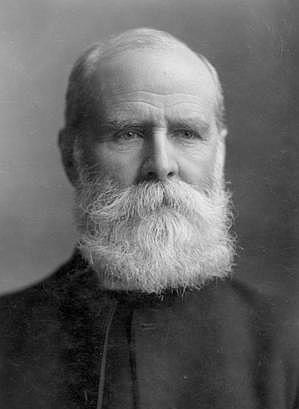 |
|
Revd. Dr. Thomas Charles Fry
(1846-1930)
led the Memorial unveiling
ceremony. |
|
Ed. − the Dean of
Lincoln was in fact the Revd. Dr. Thomas Charles Fry,
who until 1910 had been headmaster of Berkhamsted
School. Among the men whose names appear on the
memorial – Sydney
Dawe,
Roland Vaisey and
Charles (Karl)
Hartert – had been pupils there and there were
probably others. It had been the case that sons of
certain of Lord Rothschild’s tenants had been sent there
at his expense, e.g. Robert Timberlake, so I would not
be surprised if there were several who had been known to
Dr. Fry, making the unveiling of the Memorial
particularly poignant for him.
Thomas Charles Fry, born on the 16th April 1846, was
educated at Bedford School and Pembroke College,
Cambridge. He was a career schoolmaster, teaching
at Durham School and Cheltenham College and briefly
becoming headmaster of Oundle School. Resigning
that job after illness, he held a curacy before his
appointment as Headmaster of Berkhamsted School in 1887.
He left Berkhamsted School on his appointment to the
Deanery of Lincoln in 1910. |
After the General had inspected the Guard of Honour, he, with kind
consideration for the school children who were present with their
teachers, and the people generally, ordered the soldiers back, so
that as many as possible might see and hear.
The Churchwardens, Sidesmen, as well as members of our Church
Council, occupied a position close by the Cross, and the Urban
Council, headed by their Chairman, were present immediately behind
the platform.
Several of our Silver Badge men, too, were represented on the
ground, and were recognised by the General.
Many of the immediate relatives of those who have laid down their
lives stood inside the enclosure. The Local Volunteer Force
and the Fire Brigade were unable to accept the invitation that had
been extended to them, but the Special Constables were strongly
represented, and made themselves very useful.
Our Choir, led by the Cross, proceeded to the West side of the
Churchyard, and, accompanied by the Band, led the singing.
(The Hymns used being,
“For All the Saints”
“When I survey”, and
“Palms of Glory”).
Before unveiling the Memorial, General Robertson said he regarded it
as a great privilege to be asked to unveil the Cross.
It was pleasing, he said, to know, that all creeds and classes had
subscribed towards it. Nearly Nine Hundred Men, or more than
20 per cent, of the total population of this Town, had joined the
Army, and of these 600 had volunteered before the Military Service
Acts came into force. One of the men had won the highest
distinction given, that of the Victoria Cross, six had won the
Distinguished Conduct Medal, four the Military Cross, and ten the
Military Medal.
Ninety five had gained the greatest distinction of all, in that they
had given their lives.
Many went out with the Hertfordshire Territorial Battalion in
November 1914, and took part in many engagements with the Guards
Brigade in the Second Division. They were in the Second Battle
of Ypres in 1915, and the battalion lost all its officers and Men,
except for 130. Again, this year, on the Somme, they lost all
of their Officers and 500 Men. Those Men will live in History.
It was a Happy coincidence that the unveiling of the Memorial should
take place when the arrival of Peace was so near.
Our Victory was mainly attributable to the justice of our cause,
Divine Providence, the Bravery of our Seamen, Soldiers, and Airmen,
and the determination and fortitude of the Men and Women at Home.
That, he believed, was an accurate summary of the reasons why we had
won. It was not for him to speak in detail of the invaluable
services rendered by our Seamen, and Airmen, he would merely say,
that but for the devotion and Heroism of the Men of these Services,
Victory of a Military kind would have been quite impossible.
He acknowledged the great part played in the War, by our Allies,
but, when all was said and done, it remained true that History
contained no finer record of Faithful Devotion to Duty that set by
the British Soldier in all parts of the World. History contained no
more wonderful record than had been set up by the British Soldier in
France, in Italy, in Egypt, in Gallipoli, in Mesopotamia, in Syria,
and other parts of the world. The Old Regular Army, was,
perhaps the Finest Ever Seen. They went into Battle against
greatly superior numbers, and many died where they stood. They
left behind a great inspiration to the millions of their Countrymen
subsequently raised by that great patriot Lord Kitchener.
Our New Armies had to learn their lesson in the costly and stern
school of experience, but, by quickly recognising the value of
discipline, and by the most marvellous display of heroism, aptitude,
and powers of endurance, they were able to strike the enemy again
and again, until he reeled backwards, and defeated, and only saved
from complete ruin by his eager acceptance of the Armistice.
It was quite evident that troops who could withstand the onslaughts
of the Enemy in the early times, could not be beaten.
They were assembled that afternoon to dedicate that memorial to some
of those great men, and it was quite right it should be so.
Without appearing presumptuous, he would suggest that the memorial
which would do the greatest honour to their dead would be the
dedication of themselves to the completion of the work which they
had begun.
We had lost 650,000 of our men and we were too prone to forget that
if Germany had been victorious, the British Empire would have ceased
to exist, and we should have been subjected to every possible
indignity.
If our Men gave Everything, we could do no better than to follow
their example, and do our best in the difficult times to come.
In order to cope with the widespread dislocation caused by the War
we must submit to National discipline and overrule our inclinations
for the common weal. All had read of the men who, dying in
battle, called on their comrades to carry on. We should show
the same spirit.
Seeing how sound, staunch, and steadfast we had proved in these
years of War, he was prepared to believe that we were willing to,
“carry on” and show we were worthy of the men who had fought and
died for their Country.
The General then unveiled the Memorial with the words ”In the name
of the Father, the Son, and the Holy Ghost, and in the Glorious
Memory of the men and boys of Tring who have Died for their Country
I unveil this Cross”. The Dean of Lincoln before dedicating
the Memorial said it was indeed an honour to have one of our
greatest soldiers to perform that ceremony, and he thanked him most
warmly for coming.
The Dean added that he was present because amongst those
commemorated were the Sons of some of his dearest and most beloved
friends. His sorrow mingled with their sorrow and his pride with
their pride.
After the dedication, other prayers were offered by the Vicar, and
the Hymn “Palms of Glory” was sung. The National Anthem
followed, and in conclusion buglers sounded the Last Post and the
Bells of the Church broke into a muffled peal. So ended a day
which many will long remember with thankfulness.
The War Memorial Fund now stands at £480.-14s.-4d.
______________________
From the Parish Magazine
July 1919
Our War Memorial
Parishioners may like to know how the account in connection with the
Memorial now stands. All the amounts stated from time to time
in the magazine have been paid into the bank, the total now being
£485.-1s.-1d. Of this amount we have paid £357-12s.-10d. to
Messrs Norman and Burt (Burgess Hill) for the work already done to
the Memorial; £67.-0s.-0d. to Messrs Starky Gardner (Brixton) for
the iron gates guarding the Memorial; £20.-0s.-0d. on account to the
Architect Mr. Philip M. Johnston and some small sums, including the
cost of the faculty, amounting to £3-17s.-10d. This leaves a
balance in the Bank of £36.-10s.-5d.
We have still to meet the cost of carving the names, the stone
pathway around the Memorial and the remainder of the fee owing to
the Architect. We want also, a Vellum Roll to be kept in the
Church with the names and ranks and regiments of the men inscribed
on it. It would seem, therefore, that we would want a further
sum of £100.-0s.-0d. to meet our liabilities. It would be a
great comfort to the Vicar, before he leaves, and to the Church
Council, to know that the money had all be subscribed. Will
those who have not yet given, and those who feel they could give
more, let us hear from them as soon as possible.
The following paragraph which appeared lately in the Evening News
will be of interest to our readers.
“A Beautiful inscription.
Mr Walter Long’s letter in the Times on war graves reminds me
of a singularly beautiful inscription which I saw the other day on
the local War Memorial — a stone crucifix of ancient pattern — in
the Churchyard fronting the High Street at Tring, in Hertfordshire.
The inscription, which might well serve as a model to others, runs
as follows:—
1914 — 1918
Remember with Thanksgiving the true and faithful men who in these
years of
war went forth from this place for God and the Right.
The names of those who returned not again are here inscribed to be
honoured
for evermore.
R.I.P.”
______________________
From the Parish Magazine
August 1919
The Signing of the Peace Treaty
There were large congregations, both morning and evening, at the
Parish Church and St. Martha’s on Sunday, 6th July the day appointed
for National Thanksgiving for Peace. Once more too, we were
favoured with fine weather for our united outdoor service, in the
square at the south side of the Church. There was a good
attendance of Townspeople, and the singing of the three well-known
hymns, led by the Choir of the Parish Church, was hearty and
effective.
The sudden change of date for the National Rejoicings left the
various committees, which had, fortunately, already been elected to
deal with the matter in Tring, a great deal of work to do in a very
short time. However, under the tactful chairmanship of Mr. F.
J. Brown, and with the help of our energetic and capable secretary.
Mr. A. E. Hargleden, the seven committees and a large body of
splendid workers had everything ready for 19th July and, in spite of
unfavourable weather during the latter part of the day, a wonderful
programme of events, which gave a great amount of pleasure, was
carried out, in a manner which reflected great credit on the
organisers.
The Returned Soldiers Committee wisely called together those who
were to be their guests, and consulted them beforehand as to their
wishes, and many difficulties were in this way, overcome. One
thing the Soldiers all had very much at heart, was that the day
should begin with a short informal service in front of our War
Memorial, in honour of those from this Town who had lost their lives
in the Service of our Country. The Vicar, at once, arranged
for such a service to be held, as they suggested, at 11 o’clock,
and, as a London daily paper expressed it, this was one of the most
impressive incidents of the Tring Peace Celebrations. Some who
were busy in the Park at the time, have expressed a wish that the
short address which Mr. Francis gave at the beginning of the service
should be published here.

27th November 1918
– intense
feeling is etched on the faces of Dr Fry, Mr Johnston (the
architect) and General Robertson as the Vicar, the Revd Henry
Francis, reads a prayer.
He said: —
“It was very delightful, but only what we might have expected from
Comrades of The Great War, that you, unanimously, expressed a wish
that, today, your first act, as a body of men, who, by the mercy of
God Almighty have been brought back here in safety, should be to
gather in front of this Cross, and salute the gallant Dead, who
names (to the number of 105) we have all but finished carving its
steps. We ourselves in Tring have met here for a similar
purpose, when, on 27th November, this Memorial was unveiled and
dedicated to God’s Glory and their Loved Memory.
It was an occasion that many of us will not soon forget. But
today, though there is not the Pomp and Circumstance that befitted
that occasion, there is, in the very simple and informal character
of our gathering, more than sufficient to compensate for what is
lacking in outward show, for there is the heartfelt affectionate
tribute of Men to their Mates. The Men to whose memories you
would do honour today are, in every sense of the work your brothers
in Arms. Many of them you have known all your lives; they
were, some of them, your best friends, you went to school with them,
played with them and finally fought with them for the most glorious
cause for which men were ever called to fight. And ‘Those all
Died in Faith, not having received the promises, but having seen
them afar off.’ They never doubted, as has been said, but that
this Day of Triumph would Dawn.
Gladly, light heartedly, often ill taught and equipped they died
confident that the day of Victory would come. They made this,
our Thanksgiving Day possible, and we rejoice in their Confidence
and Faith. The Greatness of this Day is the measure of their
Greatness. The Glory of the Empire is their Glory they were
worthy of our Country. Therefore they would not have us weep
for them today; let there be no note of sadness in your
Thanks-giving, they would say; the fittest place where Man can die —
they remind us — is where they died — for Men.
And they Died like Him whose arms, as that figure reminds us, will
be, for ever stretched over them, and with their life blood bought
us our safety, and the World’s Freedom.
As we stand here then, on this Day of National Rejoicing, let us
resolve that their Heroic Devotion shall not be lost, let us see to
it that they have not Died in Vain.
Let us now turn the Victory of War into the Victory of Peace. And,
thank God, we do not salute them here as Dead; is it not we that
remain, who in comparison with them, are the dead? For they
are alive for evermore.
Therefore, with heads uplifted and hearts full of gratitude, we hail
the Memory of these gallant Men of Imperishable fame, our Brothers
in Arms, our Nearest and our Best, and Pray that we may hand on
untarnished to those who come after us the Priceless Heritage for
which they gave their Lives.”
After the short service Mr. C. Pearce, as Chairman of the Tring
Urban District Council, cordially welcomed the men home, and, in
Tring’s name thanked them all for all they had done and borne for
our course.
He expressed the hope that they would give their help in facing the
difficult problems that Peace brought with it, with the same courage
and determination as they had faced the problems of War, and one and
all work together to make life here happy and healthy. Captain
Macdonald Brown returned thanks on behalf of the men.
The WAR MEMORIAL

November 1918 — Tring’s newly-built War
Memorial. The names of the fallen would not be engraved on it
until the following Spring.
During September the total amount subscribed has reached
£575-5s.-10d.
The Payments are as follows:—
Messrs A.H. Day & Son for Faculty £3.-3s.-0d.
Messrs Emery and Walker Wood Block Engraving of the Design 10s.-9d.
Iron gates and carriage of same £67.-3s.-1d.
Messrs Norman and Burt Builders and Engravers £437.-6s.-11d.
Messrs A H Dawe, Work on gates etc £5.-2s.-6d.
Cheque book and sundries 3s.-0d.
Mr Philip M Johnson (Architect) £61.-16s.-0d.
TOTAL £575.-5s.-10d.
In addition to this, Miss H. C. Williams is kindly giving the Book,
beautifully bound and engraved, that will contain a complete list
including their rank and Force in which they served of all those
from this Parish who lost their lives in the service of their
country. This Book will be kept close to the Altar in our
Parish Church.
We have been shown a copy of the Cardiff Evening Express, in
which appears a large picture of our Memorial, with the words
printed above it.
“AS IT SHOULD BE”
and underneath the following:
“The only War Memorial properly completed with the Names inscribed.
Our Picture shows a beautiful War Memorial erected at Tring, in
Hertfordshire.”
――――♦――――
THE WOMEN’S LAND ARMY
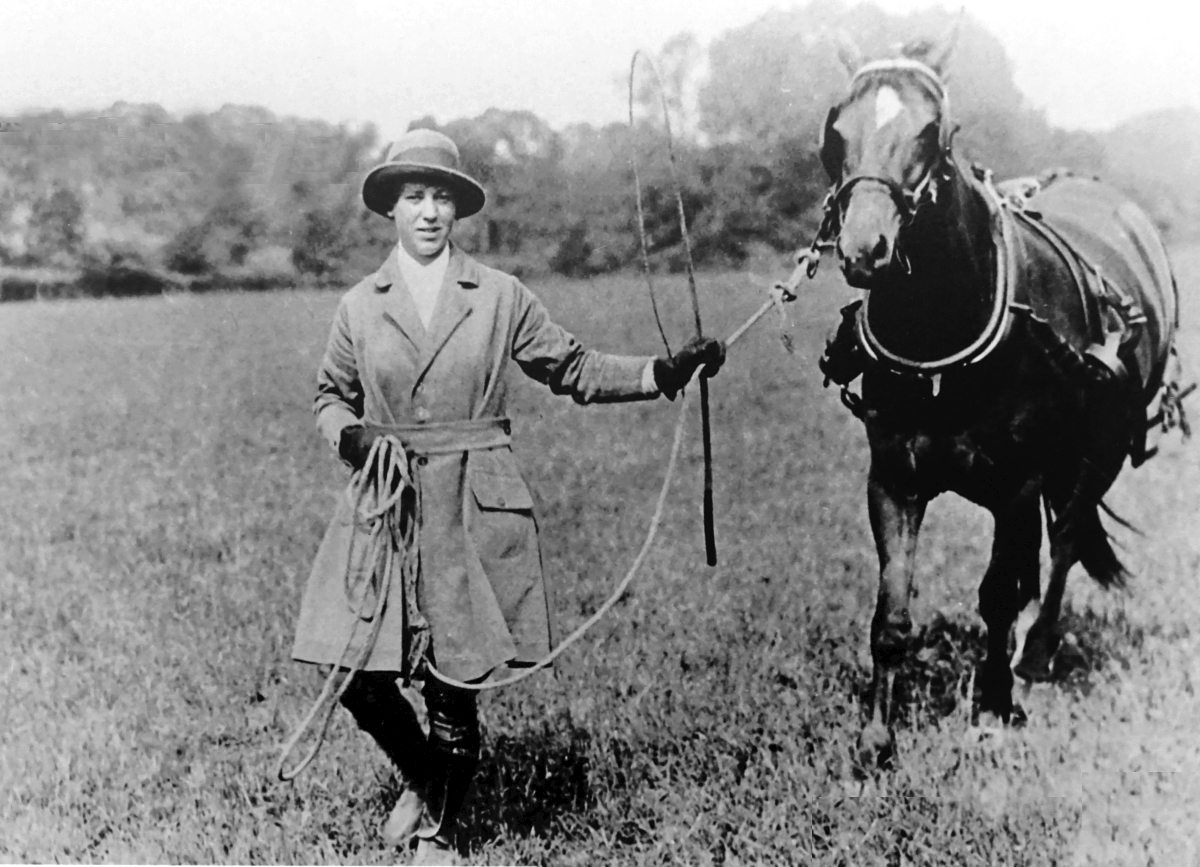
Myryl Smith of
Tring,
Women’s Land Army.
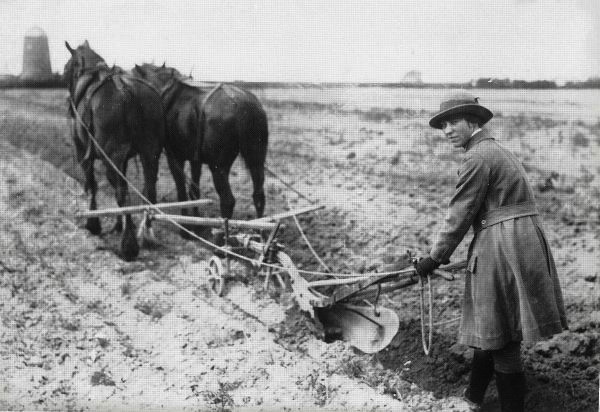
During the First World War there was a shortage of farm labour as
men were conscripted into the armed forces. By 1917, shipping
losses from the German U-boat campaign were having a severe impact
on our food supplies and there was an urgent need to grow more food.
This led to the establishment of the Women’s Land Army.
Although Myryl didn’t take up arms, she and other Land Army girls
took over the work of absent farm workers and “fought in the
fields”, helping to stave off starvation.
This picture was taken in
Goldfield, the field that was once at the top of Miswell Lane and
Icknield Way (now houses) where Goldfield Windmill (in the
background above) stands.
Myryl Smith worked at farms in Tring. She was given no formal
training and later recalled that the work was ‘all instinct’.
Commencing work at 5 am daily, Myryl’s tasks were varied and
included ploughing, looking after cattle, milking, feeding farm
animals and looking after the farm’s accounts.
One enticing aspect of the Women’s Land Army was the uniform,
specifically the wearing of breeches, which at the time was
positively revolutionary! As part of her uniform Myryl Smith
wore a pair of leather Land Army boots which came above the calf leg
and a waterproof coat. Myryl recollected how the sight of a woman in
uniform provoked much interest amongst the locals and humorously
recalled how “all the heads would be round the doors’ trying to
catch a glimpse of her.”
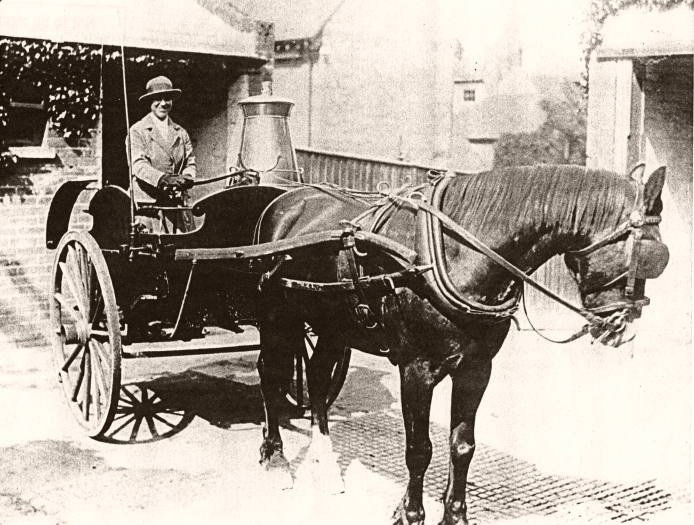
Myryl delivered milk to most of Tring with a horse-drawn cart, a
physically arduous task. After her day’s work she volunteered
at a local canteen for two hours each evening serving meals to local
men on leave from the front. In recognition of her service she
was awarded the ‘Order of the Red Triangle’ by the YMCA.
――――♦――――

<>
|
|